Evolution of Cell Phones
Introduction.
To begin with, let us mention that nowadays people do not imagine life without a cell phone. For us it is no more a wonder of engineering, but a usual means of communication and it is more likely that a person without a cell phone will be considered an odd person.
It should be mentioned that the idea of person-to-person wireless communication is not new.
In 1901 Prof. William Ayrton predicted: “a time when if a person wanted to call to a friend he knew not where, he would call in a loud, electromagnetic voice, heard by him who had the electromagnetic ear, silent to him who had it not” (Hamill and Lasen 4).

The popularity of cell phones
“The telephone is generally acknowledged to have been invented by the Scottish-Canadian Alexander Bell working in Boston in 1876” (Noll 32). Thus, we have an opportunity to communicate at distance for more than a century already, but mobile phone communication became especially popular and widespread not more than a decade ago and today we can hardly imagine our life without it. What makes it so popular? The answer to this question is evident: a cell phone does not require any special skill to use it; even children can speak on the cell phone. At the same time, in comparison with other ways of indirect communication, such as, for instance, mail or even e-mail, cell phones are much more convenient, for they can transfer human voice. And it is evident, that communication by means of voice only maybe sometimes much more pleasant and useful than even face-to-face communication.
It must be mentioned that cell phone has some more names: cellular phone, mobile phone, wireless phone or handset. Still, all of them stand for a device that usually has “a monochrome or color screen display, a built-in antenna and a key-pad” (Zheng and Ni 32).
Cell phones of the first generation
It will be interesting to mention that the first cell phone was made by Dr. Martin Cooper, who worked as an engineer at Motorola at that time. So, the historic date in the development of cell phones was April 13, 1978, when Martin Cooper made a first phone call using the first cell phone, the Motorola DynaTac, when he was walking along a street in New York (Zheng and Ni 32). It is not difficult to guess that visually this first mobile telephone looked like a brick, and it was rather heavy and needed charging very often. This is why it could be called “movable”, but not “mobile”. Such were the cell phones of the first generation.
Cell phones of the second generation
Speaking about mobile phones that belong to the second generation, such digital cellular systems as GSM, cdmaOne and TDMA must be mentioned (Zheng and Ni 32). Due to high technologies these phones are very light and comparatively small, they provide long talk time. These phones are also equipped with LCD screen display, which can show phone numbers, messages etc. “Clamshell” phones, which had a screen display on the back of the cover pane, became to appear after palm-like phones (Zheng and Ni 32).
Nowadays cell phones are equipped with brightly colored screens. They have a lot of additional functions, such as synchronization with computers; moreover, they are equipped with IrDA, Bluetooth.
Finally, smartphones that were developed in late 1990s should be mentioned. These devices are equipped with the latest mobile processors such as Intel XScale and they are characterized by high-resolution color LCD screens and impressive memory capacities (Zheng and Ni 32). A smartphone may be used as a music player or it can function as a digital camera and computer as well.
Drawing a conclusion, let us say that phones and cell phones have changed greatly in the course of their development. Moreover, technical revolution is even more promising. We cannot even imagine the way a cell phone will look in some ten or twenty years.
Works Cited
Hamill, Lynne, and Amparo Lasen. Mobile World: Past, Present and Future. USA: Springer, 2005.
Noll, Michael A. The Evolution of Media. USA: Rowman & Littlefield, 2005.
Zheng, Pei, and Lionel M. Ni. Smart Phone and the Next Generation Mobile Computing. San Francisco: Morgan Kaufmann, 2006.
Cite this paper
- Chicago (N-B)
- Chicago (A-D)
StudyCorgi. (2021, November 9). Evolution of Cell Phones. https://studycorgi.com/evolution-of-cell-phones/
"Evolution of Cell Phones." StudyCorgi , 9 Nov. 2021, studycorgi.com/evolution-of-cell-phones/.
StudyCorgi . (2021) 'Evolution of Cell Phones'. 9 November.
1. StudyCorgi . "Evolution of Cell Phones." November 9, 2021. https://studycorgi.com/evolution-of-cell-phones/.
Bibliography
StudyCorgi . "Evolution of Cell Phones." November 9, 2021. https://studycorgi.com/evolution-of-cell-phones/.
StudyCorgi . 2021. "Evolution of Cell Phones." November 9, 2021. https://studycorgi.com/evolution-of-cell-phones/.
This paper, “Evolution of Cell Phones”, was written and voluntary submitted to our free essay database by a straight-A student. Please ensure you properly reference the paper if you're using it to write your assignment.
Before publication, the StudyCorgi editorial team proofread and checked the paper to make sure it meets the highest standards in terms of grammar, punctuation, style, fact accuracy, copyright issues, and inclusive language. Last updated: November 10, 2023 .
If you are the author of this paper and no longer wish to have it published on StudyCorgi, request the removal . Please use the “ Donate your paper ” form to submit an essay.
Home — Essay Samples — Information Science and Technology — Cell Phones — Cell Phones: Then and Now
Cell Phones: then and Now
- Categories: Cell Phones Gadgets
About this sample

Words: 718 |
Published: Sep 1, 2023
Words: 718 | Pages: 2 | 4 min read

Cite this Essay
Let us write you an essay from scratch
- 450+ experts on 30 subjects ready to help
- Custom essay delivered in as few as 3 hours
Get high-quality help

Prof. Kifaru
Verified writer
- Expert in: Information Science and Technology

+ 120 experts online
By clicking “Check Writers’ Offers”, you agree to our terms of service and privacy policy . We’ll occasionally send you promo and account related email
No need to pay just yet!
Related Essays
3 pages / 1389 words
6 pages / 2732 words
2 pages / 848 words
3 pages / 1378 words
Remember! This is just a sample.
You can get your custom paper by one of our expert writers.
121 writers online
Still can’t find what you need?
Browse our vast selection of original essay samples, each expertly formatted and styled
Related Essays on Cell Phones
Functional analysis is a model of psychological formulation designed to understand the functions of human behavior. It has its origins in behavioral psychology. At its core, functional analysis assumes that all behavior is [...]
Cell phones in schools have been a topic of debate for years, and the discourse continues to evolve. The core question remains: should cell phones be allowed in school? In this argumentative essay, we will delve deeper into this [...]
During the 1990s, cell phones began to emerge into the world. They were big boxes that were similar to the cell phone line which is used in modern day. They had huge antennas and were heavy for people to carry around. This was [...]
In today's digital age, cell phones have become an integral part of our daily lives, including in the classroom setting. The debate over whether cell phones should be allowed in schools has been ongoing, with proponents arguing [...]
The cellphone has become in an essential device for everybody. On the streets, trains, supermarkets even driving a car, you can see people on their phones. If you forget your cellphone at home, probably you’re going to come back [...]
Cell phones have become an integral part of our daily lives, and their presence is especially prominent in the lives of teenagers. With the rise of smartphones and the increasing reliance on technology, the debate over whether [...]
Related Topics
By clicking “Send”, you agree to our Terms of service and Privacy statement . We will occasionally send you account related emails.
Where do you want us to send this sample?
By clicking “Continue”, you agree to our terms of service and privacy policy.
Be careful. This essay is not unique
This essay was donated by a student and is likely to have been used and submitted before
Download this Sample
Free samples may contain mistakes and not unique parts
Sorry, we could not paraphrase this essay. Our professional writers can rewrite it and get you a unique paper.
Please check your inbox.
We can write you a custom essay that will follow your exact instructions and meet the deadlines. Let's fix your grades together!
Get Your Personalized Essay in 3 Hours or Less!
We use cookies to personalyze your web-site experience. By continuing we’ll assume you board with our cookie policy .
- Instructions Followed To The Letter
- Deadlines Met At Every Stage
- Unique And Plagiarism Free
Search results for
Affiliate links on Android Authority may earn us a commission. Learn more.
The history of cell phones: A decade-by-decade timeline
Published on March 20, 2024
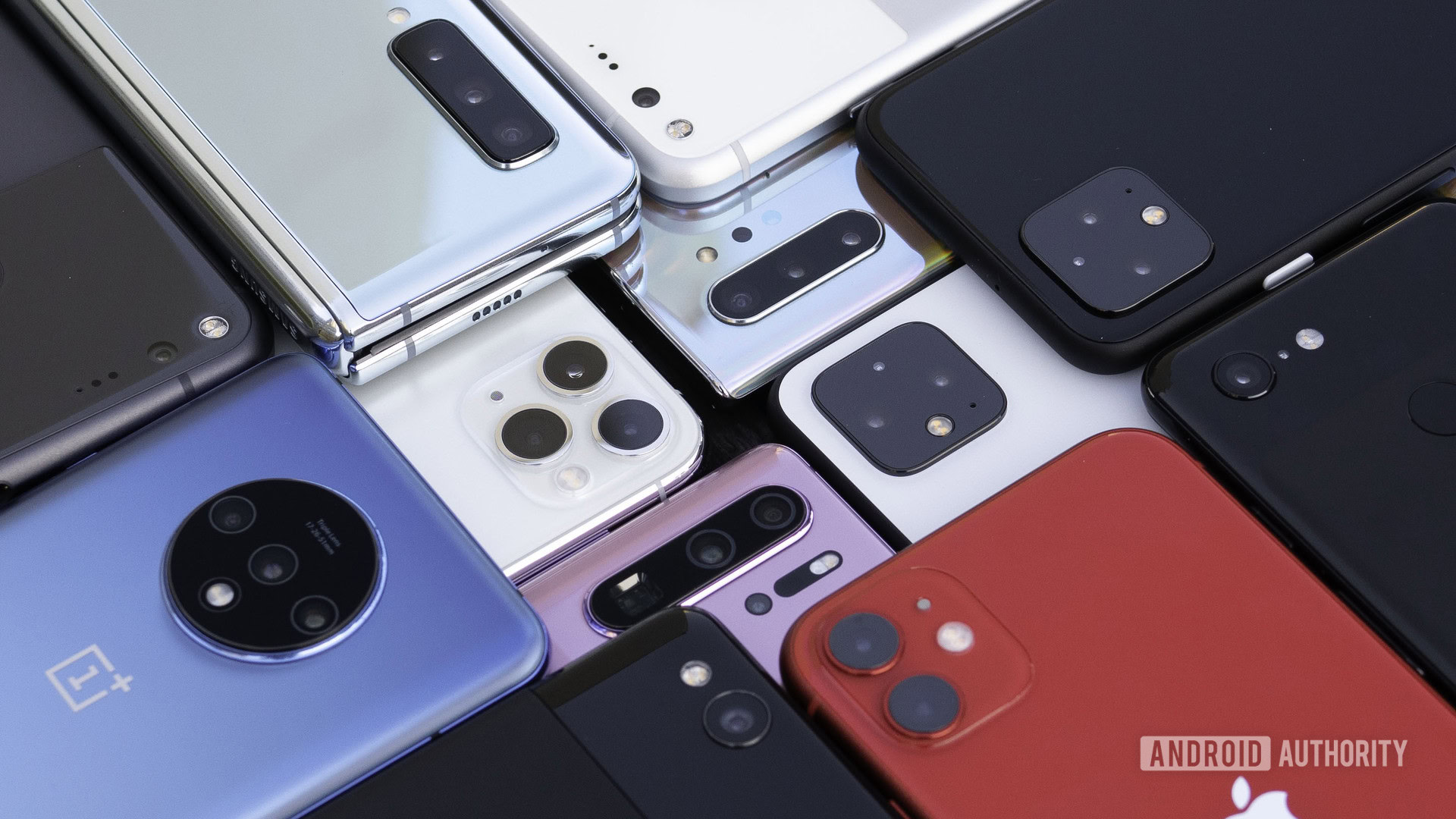
In just a few decades, mobile phones have gone from a luxury reserved for the elite to an essential tool for billions of users. From the first in-car phones of the 1940s to the best smartphones of today, the evolution of cell phones is nothing short of remarkable. To that end, let’s look at the history of cell phones. We’ll go through the evolution one decade at a time — from the first-ever wireless network to the proliferation of mobile apps, it’s all here.
Early portable phones: Pre-1970s cell phone history

The modern cell phone owes its existence to automobiles and trains, two industries that adopted wireless communication nearly a century ago. In the 1920s, German company Zugtelephonie AG developed and sold wireless telephony equipment to train operators. A couple of years later, the service was offered to first-class travelers on the route between Hamburg and Berlin.
Then, during the Second World War, the Allied powers deployed over 130,000 units of the SCR-536 Handie-Talkie (pictured above). This bulky contraption was essentially an entirely handheld two-way radio transceiver. As you’d expect from such an early technology, it suffered many drawbacks, including short battery life and a lackluster range of just one mile depending on the terrain. Still, it was more than useable, and the company behind it would eventually become the Motorola we know today.
After the war ended, American company Bell Labs began working on an in-car system allowing users to place calls from anywhere. This led to the Mobile Telephone Service (MTS) launch in 1946, or the first-ever wireless telephony system.
Bell Labs’ car phone equipment weighed 80 pounds in its first generation. And even with all that weight, you could only use it in major US cities and along select highways. Despite these limitations, the service quickly gained popularity. It became so popular that the service quickly reached its maximum capacity due to the limited radio channels available at each base station. Users would have to wait in line for a channel to become available.
Car phones became increasingly popular among businesses and wealthy individuals in the 1950s and 1960s, but the high cost meant they remained out of reach for most people.
The 1970s and 1980s: The first mobile phone
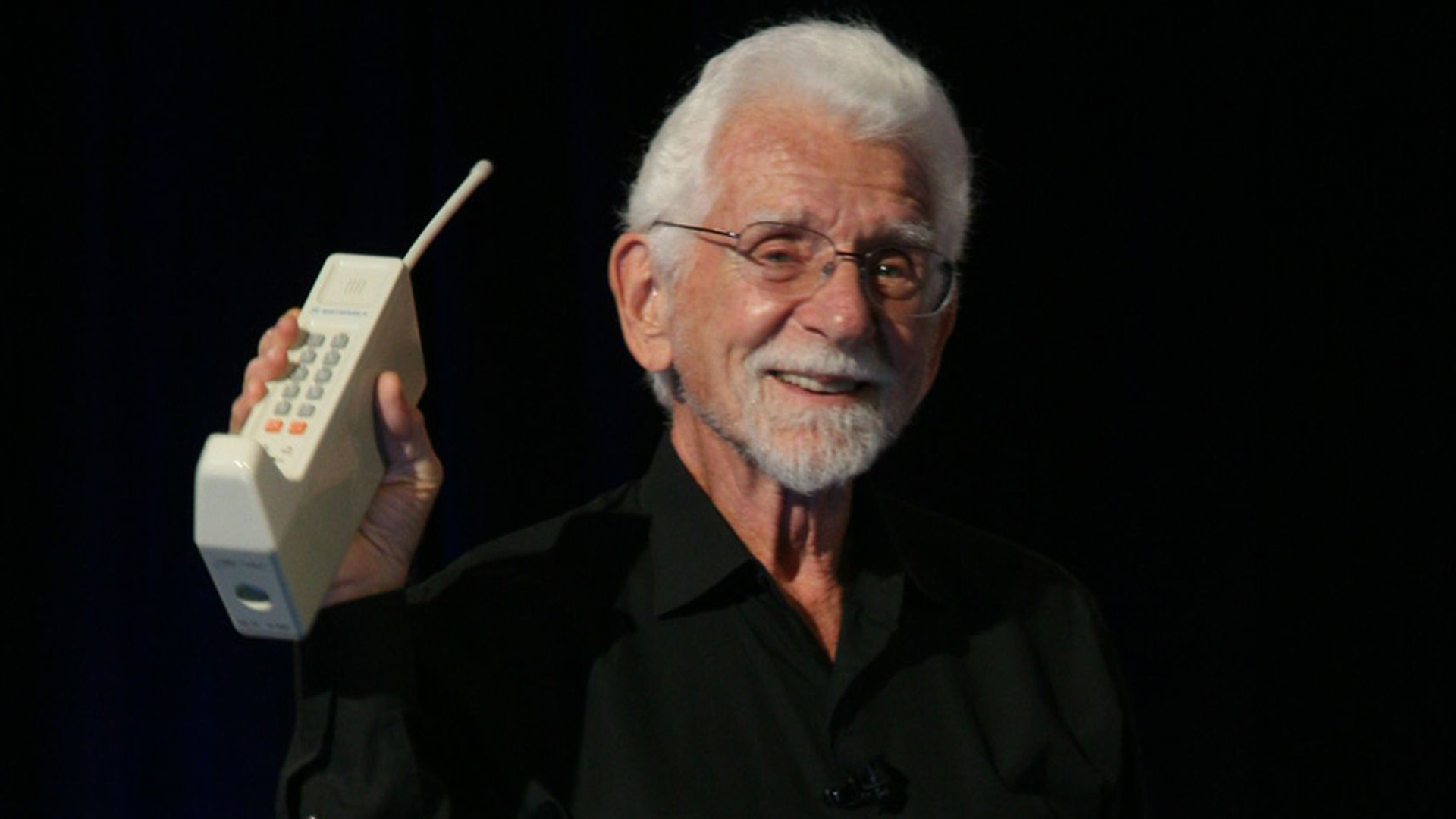
After decades of research and development, Motorola unveiled the world’s first cell phone prototype in 1973. Martin Cooper, the Motorola engineer who led the development of this invention, invited reporters to witness the first-ever wireless phone call. He then proceeded to ring his direct rival, Joel S. Engel of Bell Labs, from the streets of New York City.
However, Motorola wasn’t ready to put cell phones in their customers’ pockets yet. It would take a full decade and over $100 million to develop a final, consumer-ready version. In 1983, Motorola would finally go to market with the DynaTAC 8000X. The phone was nearly a foot long and weighed roughly 2.5 lbs (over a kilogram). Still, anyone could buy one, which was revolutionary enough then. And despite its eye-watering $4,000 asking price, Motorola reportedly couldn’t manufacture enough units to keep up with demand.
The DynaTAC 8000X used a brand-new cellular network, specifically Bell Labs’ Advanced Mobile Phone System (AMPS). These days, we refer to AMPS as a first-generation cellular network (1G) or the precursor to 2G. AMPS was susceptible to signal noise and static as a purely analog network. It didn’t support text messaging or SMS either. The DynaTAC 8000X could store 30 contacts but offered little else in the way of features otherwise.
It didn’t take long for more companies to follow in Motorola’s footsteps. Nokia, for example, entered the cell phone market in 1987 with the Mobira Cityman 900. The phone’s 1.6 lbs (760g) weight represented a significant upgrade over the DynaTAC. Another year later, Samsung released its first-ever cell phone in 1988 with the SH-100.
The birth of 2G and GSM
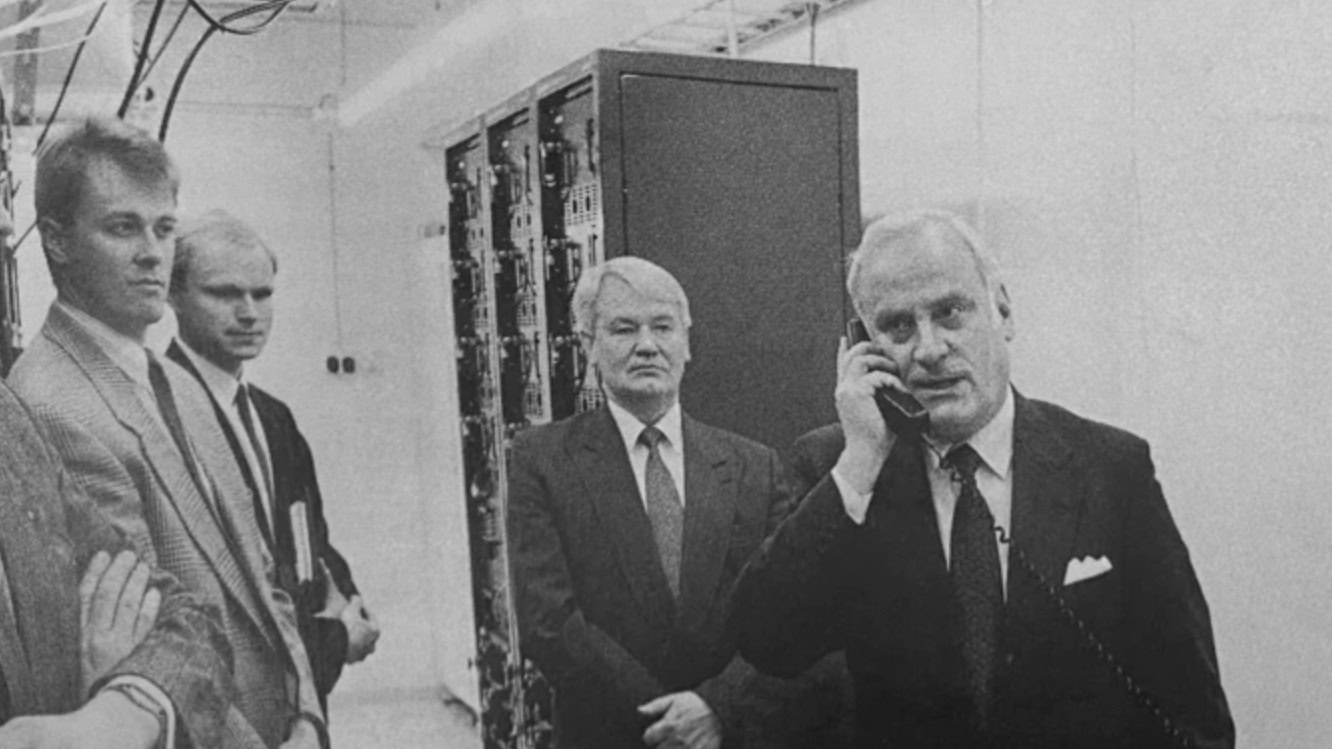
The 1990s marked a time of rapid change in the cell phone industry, particularly with the release of smaller and more portable devices. But arguably, the most important development of this decade was the Global System for Mobile communications (GSM), the first fully digital cellular standard. In 1991, GSM’s efficiency was perceived as a necessary advancement as the existing analog network rapidly approached maximum capacity. These days, we refer to GSM and CDMA as second-generation cellular networks or simply 2G.
GSM didn’t just improve call quality; it paved the way for text messaging and eventually brought the internet to mobile phones. It also used encryption by default, meaning that you could finally have a conversation without the fear of being eavesdropped on. Finally, worldwide GSM adoption meant users could swap SIM cards to switch carriers.
The 1990s: SMS and the world’s first smartphone
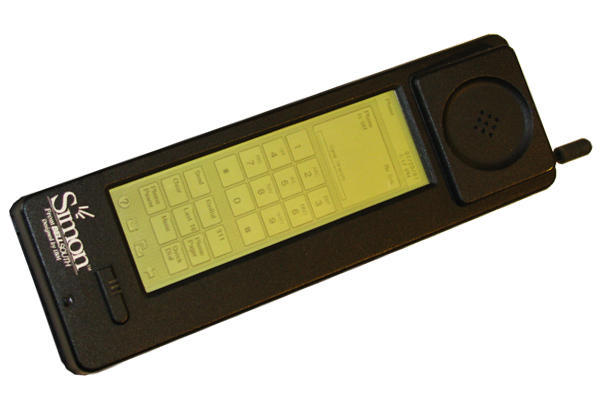
Even though SMS was built into the GSM standard, it would take another couple of years before Nokia would release the world’s first phone capable of composing a text message. Released in 1994, the Nokia 2010 featured a numeric keypad with letter mappings for text input. This became the standard layout for cell phone keypads until full QWERTY keyboards and touchscreens arrived.
As Finnish company Nokia made a name for itself, other electronics giants like IBM and Ericsson also began to test the waters. In 1994, IBM partnered with wireless carrier BellSouth (now merged with AT&T ) to sell the Simon — the first phone to also function as a touchscreen PDA. The Simon had a vast feature set for its time, including an address book, calendar, and notepad. It could also send and receive emails and fax messages.
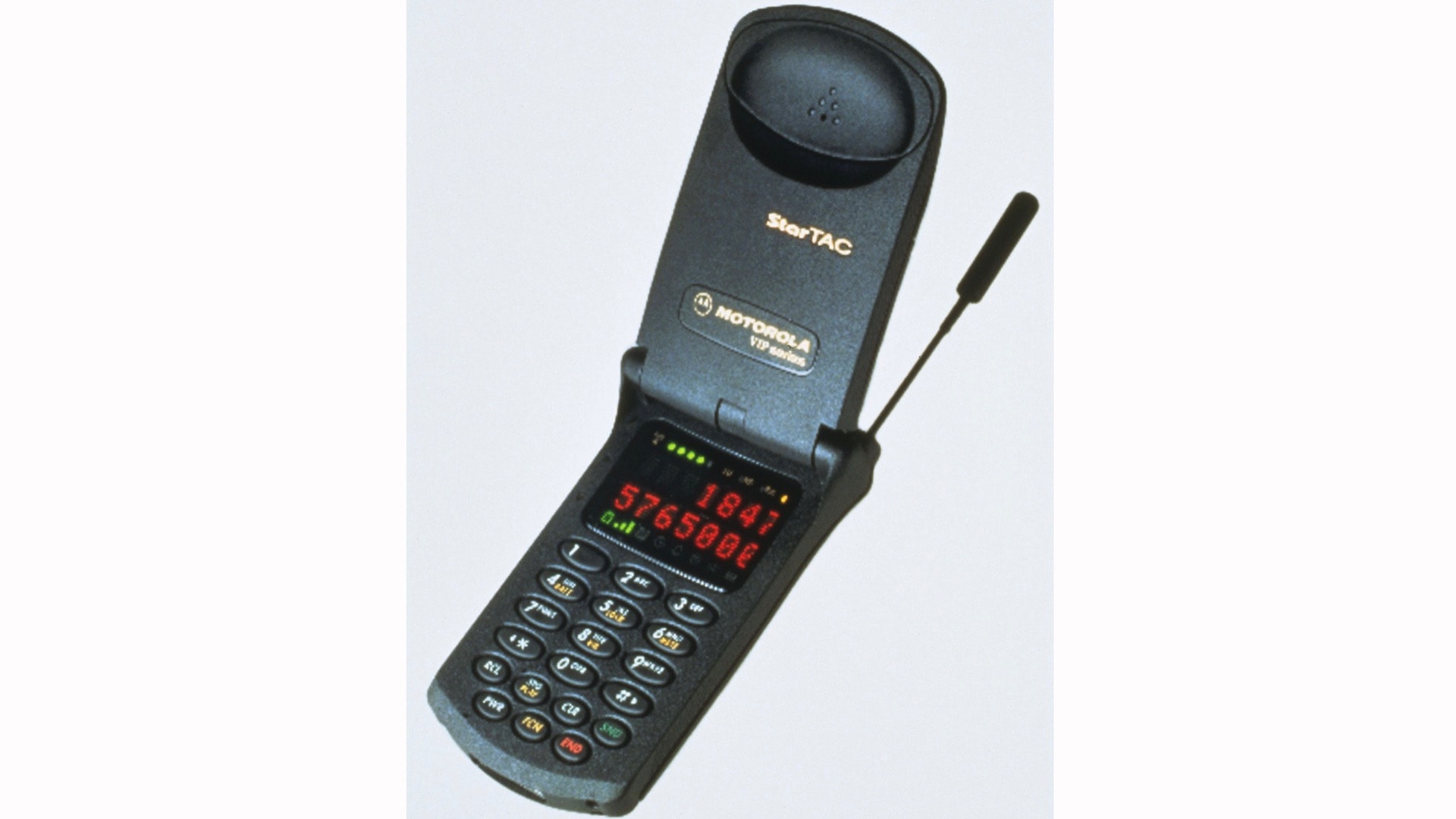
In the couple of years that followed, handset makers began experimenting with various form factors. The Nokia 8110, for example, earned the “banana phone” nickname due to its prominent curvature and sliding form factor. It even made an appearance in the 1999 blockbuster The Matrix.
Motorola, meanwhile, released the first-ever clamshell-style flip phone in 1996. The StarTAC’s top half folded down to protect the display and keypad. However, Motorola’s big selling point for the device was its impressive 3oz (88g) weight.
Towards the end of the 20th century, we also saw the future potential of cell phones with the BlackBerry 850. The device featured a 32-bit Intel processor, a full horizontal keyboard, and encrypted email software — all for just $400. The company behind BlackBerry, Research in Motion, would go on to dominate the enterprise cell phone market over the next decade.
Early 2000s: A turning point in cell phone history
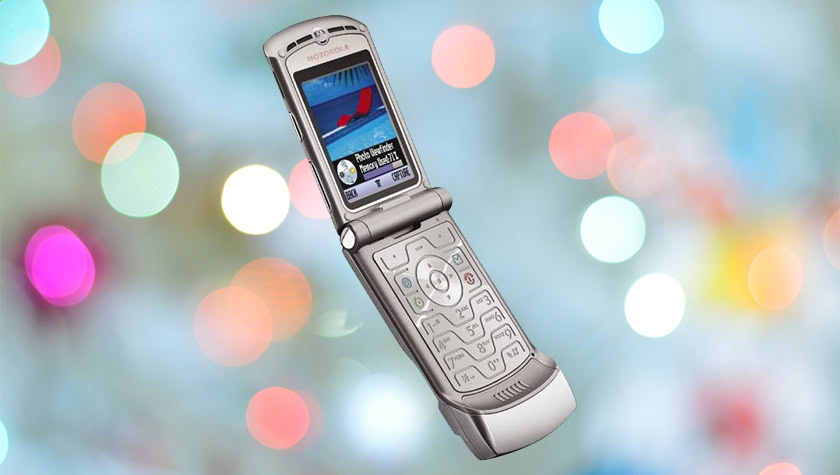
While the 2000s started off with carriers like DoCoMo in Japan testing 3G cellular service, the system wouldn’t catch on for a while. Cell phone manufacturers, meanwhile, found themselves amid an intense race to innovate and outperform the competition.
The decade saw the rise of full-color LCD displays and multimedia features like audio playback. Phones could also access the internet at faster speeds via the GSM-based General Packet Radio Service (GPRS). Sony and Ericsson made the first phone to include Bluetooth connectivity as early as 2001.
The Sharp J-SH04, meanwhile, became the first cell phone to feature a camera. Launched in the year 2000, the phone was sold exclusively in Japan. Two years later, Sanyo and Sprint teamed up to release the first camera phone in the US. The SCP-5300 featured a 0.3-megapixel camera, a color display, and a clamshell form factor. At $400, it was reasonably priced and almost universally praised. The slew of stellar budget camera phones available in today’s market shows just how far the industry has come.
The next few years saw device makers experimenting with form factors yet again. Nokia unveiled its infamous GameBoy-like N-Gage, and BlackBerry brought QWERTY keyboards to the mainstream with the Quark series.
And for the first time in the history of cell phones, designs started to resemble fashion accessories rather than utilitarian tools. The Motorola Razr V3 was perhaps the perfect embodiment of this trend with its magnesium-aluminum build and unbelievably sleek profile. It went on to become the best-selling clamshell phone of all time. According to many estimates, Motorola sold well over 100 million units of the Razr V3 in the four years between 2004 and 2008.
The early 2000s witnessed a market share split between Symbian, Palm OS, and Windows Mobile operating systems. These platforms rapidly gained key features like PDF rendering, video conferencing, copy-paste, and even support for third-party apps, paving the way for full-fledged smartphones.
The late 2000s: The first iPhone and Android 1.0
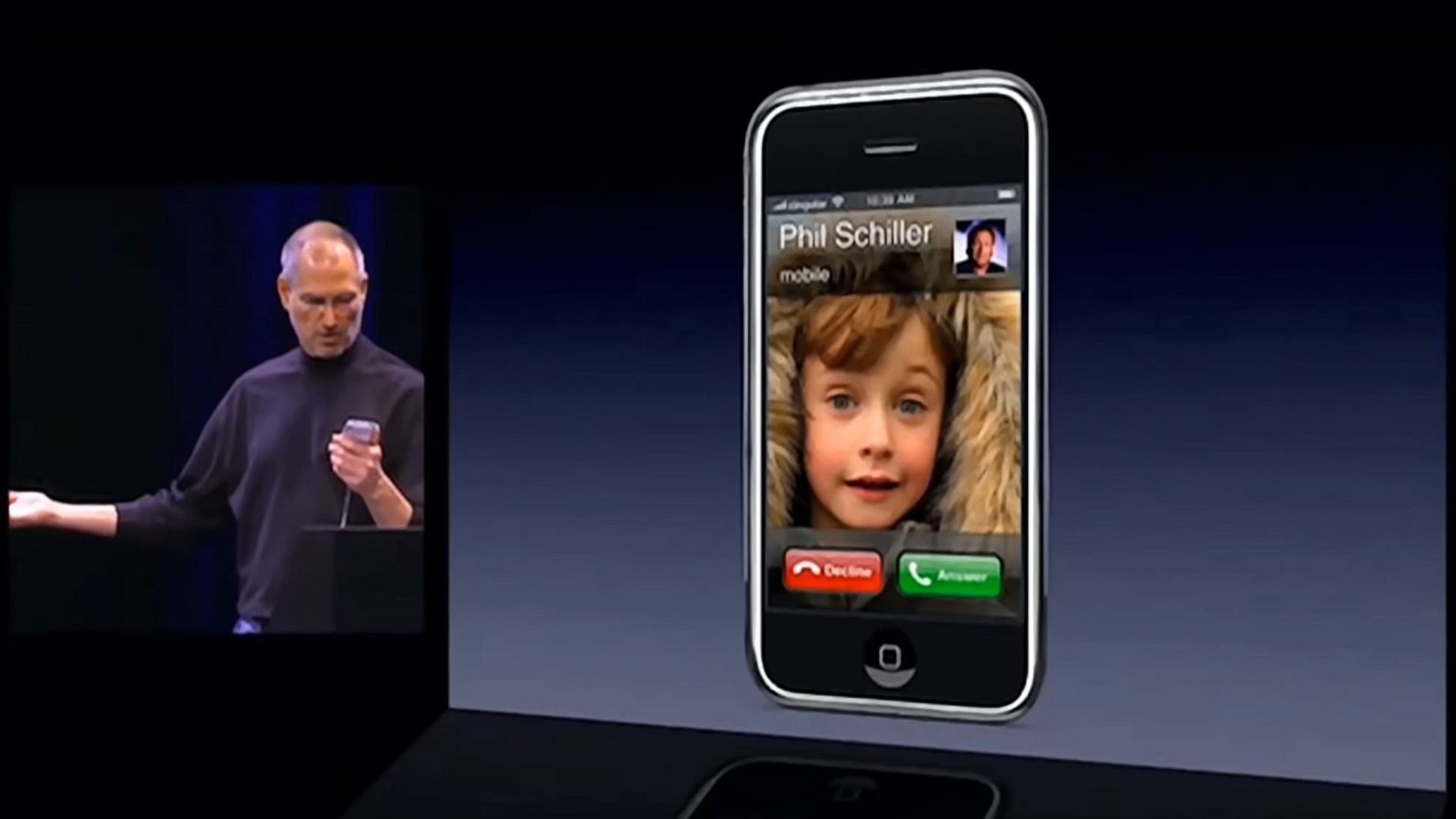
Competition in the cell phone market began heating up in the latter half of the 2000s. And despite a looming recession, consumer demand remained high worldwide.
In 2007, Apple entered the cell phone market with the iPhone . The company announced it as “a revolutionary mobile phone, a widescreen iPod with touch controls, and a breakthrough Internet communications device.” Indeed, it was the first phone to fully embrace the touch interface and fulfill three use cases in a single device.
While touchscreen phones already existed at the time, the iPhone didn’t need a stylus and used cutting-edge capacitive hardware instead. Apple’s clever software innovations like multi-touch were an added bonus. The iPhone’s large display also enabled browsing the internet on a relatively compact device for the first time. Likewise, it was the first cell phone in history to include dedicated YouTube and Google Maps apps.
Apple introduced the App Store in 2008, unlocking new functionality through third-party apps. It ended up being a wildly successful move. Facebook, one of the most popular apps on the digital storefront at the time, gained over a million downloads before the year ended.
The iPhone’s success single-handedly popularized the notion of modern-day smartphones. It prompted Google to rethink its strategy with Android — the mobile operating system it was developing behind closed doors at the time. When Android debuted on the HTCG1 in 2008, Google ensured it included a large touchscreen, a fully-featured web browser, and the Android Market app store. The rest is history.
The early 2010s: iPhone and Android take over
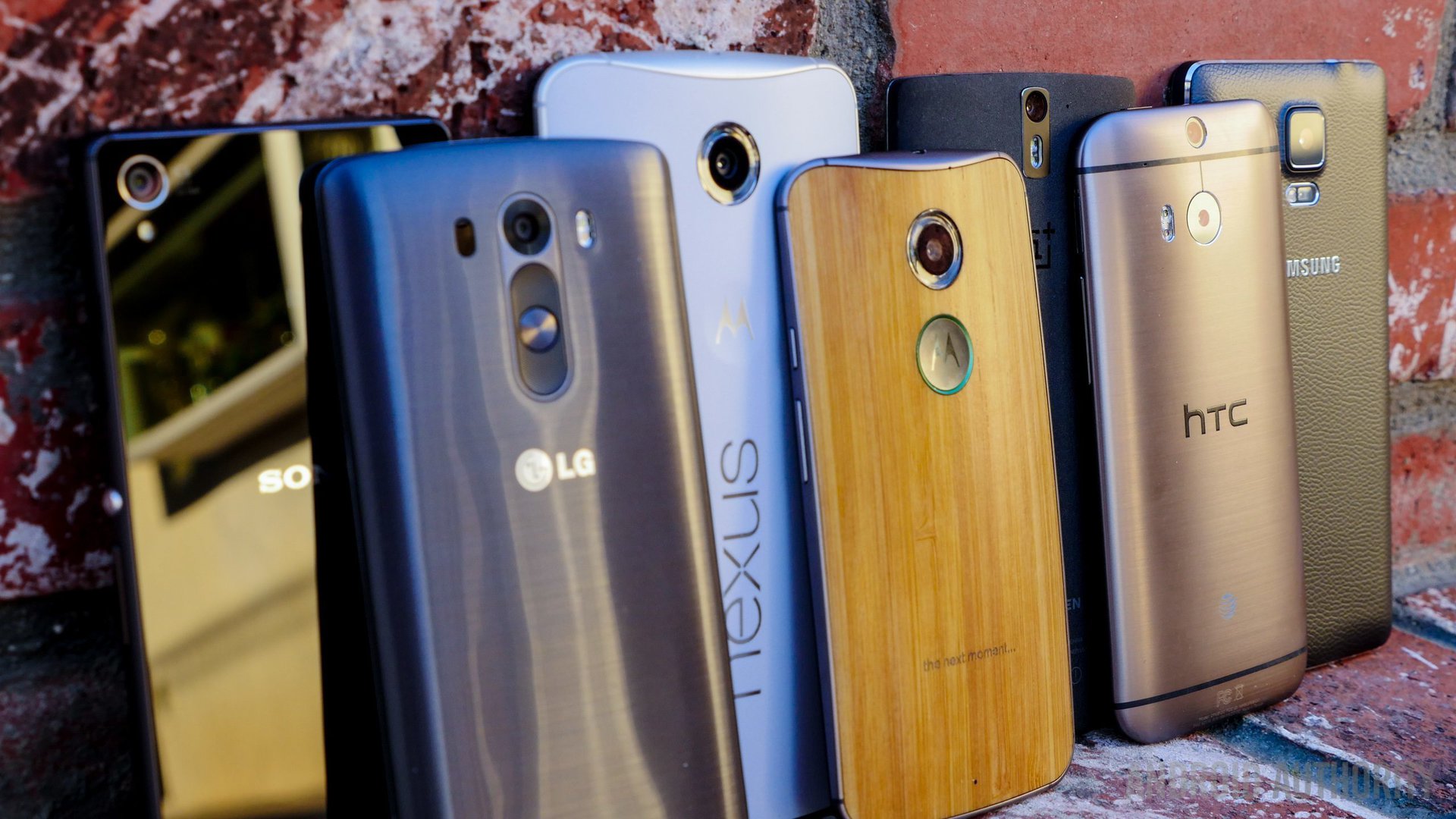
The early 2010s marked a period of consolidation in the cell phone industry. Consumers demanded a feature-rich software experience that matched the iPhone, but not every player could deliver. Symbian, BlackBerry OS, and Windows Mobile all received major overhauls. However, they couldn’t keep up with the rich app ecosystems of Apple’s iOS and Google’s Android.
As for design trends, physical buttons on cell phones were clearly on the way out even as early as 2010. The Samsung Galaxy S, for example, switched to capacitive touch buttons on the front, leaving just a single physical home button. Only a few years later, phones would feature edge-to-edge displays with no front-facing buttons whatsoever.
Cellular data speeds improved considerably in this decade, thanks to the widespread adoption of 4G LTE. The first Android phone to feature 4G connectivity was the HTCEvo in 2010. Apple would later bring LTE to the iPhone 5 in 2012.
Around this time, the industry witnessed a big push toward improving camera quality. The Nokia 808 PureView blew the competition away with its large 41-megapixel camera sensor. Similarly, the Lumia 920 became the first phone to include optical image stabilization (OIS). And in 2018, HUAWEI introduced the world’s first triple-camera phone — the P20 Pro.
The 2010s also introduced lesser-known hardware firsts like Near Field Communication (NFC), eSIM support, and water resistance (IP ratings). Samsung even brought heart rate and blood oxygen saturation sensors to its Galaxy S series smartphones. Qi wireless charging gained momentum after 2012, too, with Nokia being the first to adopt it in the Lumia 920.
Late 2010s and early 2020s: The future of smartphones
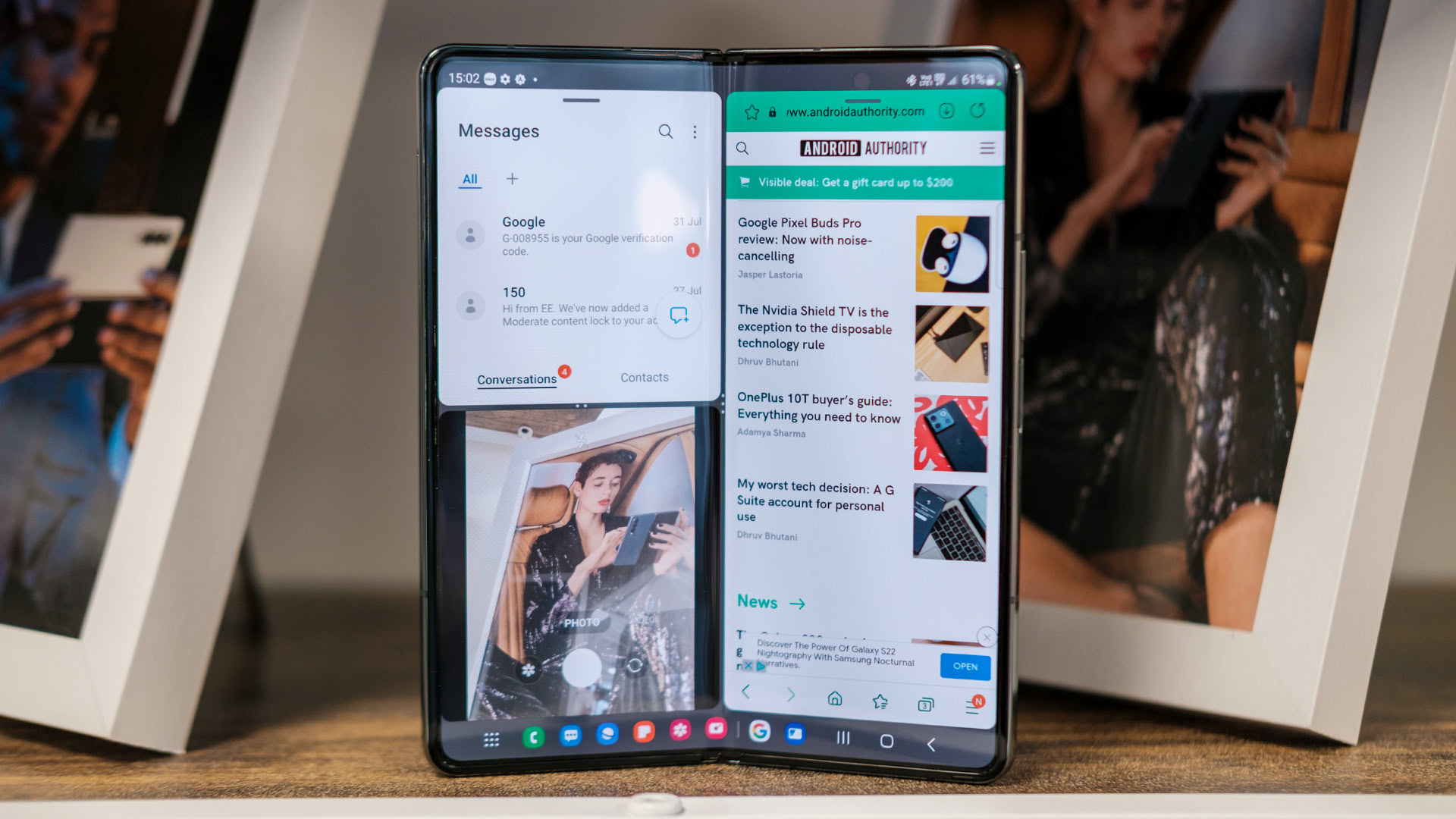
The late 2010s finally catapulted the cell phone market beyond low-resolution camera sensors. Handset manufacturers like Google, with its Nexus and Pixel series, and HUAWEI also began to combine large camera sensors with cutting-edge software. The result? Smartphone cameras yielded images that rivaled dedicated point-and-shoot cameras despite the latter having more capable hardware. It didn’t take long for other handset makers to catch up. Today, virtually every smartphone on the market relies on computational photography, albeit to a varying degree.
This period also marked the rise of the foldable form factor. Technically, the Royole FlexPai holds the record as the first-ever foldable phone . However, it wasn’t until the Motorola Razr and Samsung Galaxy Z Fold launched in 2019 that the market took off in earnest. Now, the likes of Google , OnePlus , and OPPO have debuted foldable phones.
Setting aside the new foldable form factor and camera improvements, it may seem like cell phone advancement slowed down in the 2020s. However, there’s still much to look forward to as handset makers experiment with under-display cameras, magnetic accessories, and generative AI and machine learning-based software features. And if that isn’t enough, the latest iPhone can directly communicate with satellites in space, marking a new chapter in cell phone connectivity.
You might like
- Entertainment
- Environment
- Information Science and Technology
- Social Issues
Home Essay Samples Information Science and Technology Cell Phones
About The Evolution and Impact of Cell Phones
Table of contents, the dawn of communication: early cell phones, the era of connectivity: rise of the smartphone, shaping modern society, the challenges and considerations, conclusion: a technological revolution.
*minimum deadline
Cite this Essay
To export a reference to this article please select a referencing style below

- Data Analysis
- Cloud Computing
- Computer Graphics
- Self Driving Cars
- Operating System
Related Essays
Need writing help?
You can always rely on us no matter what type of paper you need
*No hidden charges
100% Unique Essays
Absolutely Confidential
Money Back Guarantee
By clicking “Send Essay”, you agree to our Terms of service and Privacy statement. We will occasionally send you account related emails
You can also get a UNIQUE essay on this or any other topic
Thank you! We’ll contact you as soon as possible.
History Cooperative
The Complete History of Phones from the Last 500 Years
Today, mobile phones fit in the palm of our hands, and laptops fit in our bags, making communication seem compact and accessible. But, the history of phones goes way back.
Teenagers today may not have experienced this, but in the olden days, before the time of the convenient handheld mobile phone, telephones had cords and antennas.
Telephone systems were usually entirely analog devices with little digital screens. At that time, no one imagined that digital cordless phones would come and take over the market.
Just like cell phones did not come out of anywhere, the telephone system has a series of predecessors too.
Here is a brief history of the telephone, beginning from the earliest forms of audio transmission to the invention of the first cell phone:
Table of Contents
The History of Phones: The Earliest Audio Communication Devices
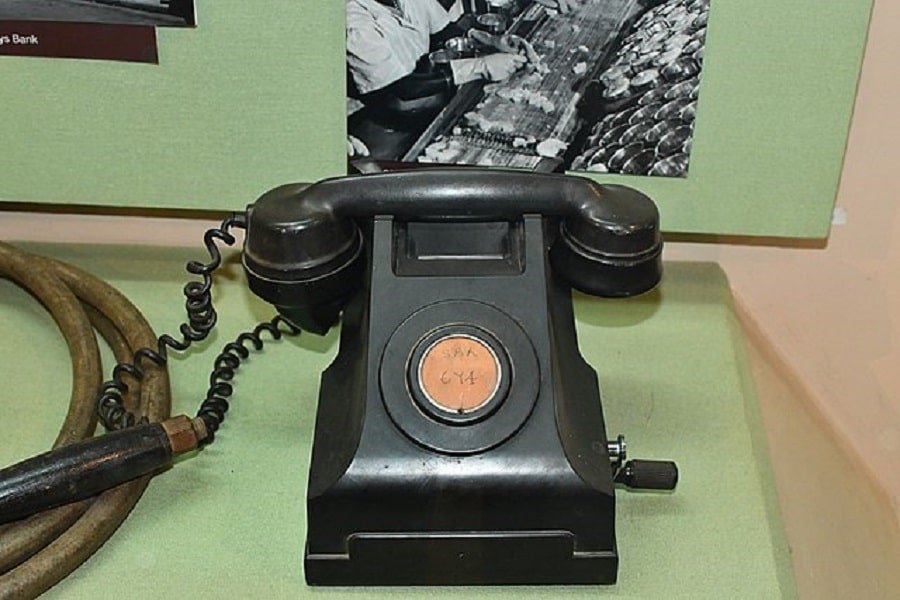
With the industrial revolution in full swing and wars becoming increasingly mechanical, it was only a matter of time before someone came along with the idea of audio transmission.
There are a few devices that preceded and, consequently, led to the invention of the telephone:
Mechanical Devices
Mechanical and acoustic devices for the transmission of speech and music go back a long way. As far back as the 17th century, people were experimenting with pipes, strings, and similar media to transmit sound.
The earliest examples of this phenomenon were acoustic in nature like the tin can telephone.
Tin Can Telephone
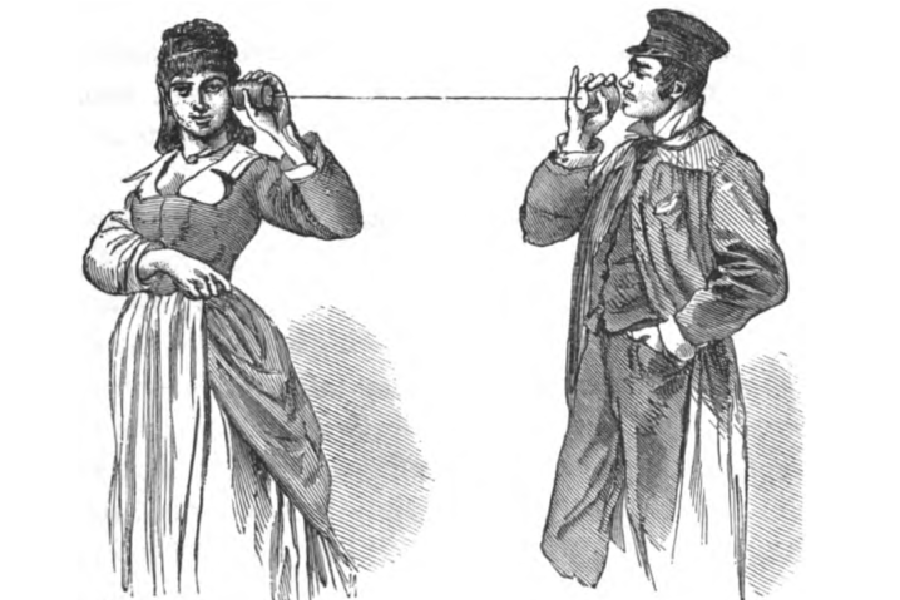
A tin can telephone network was a rudimentary speech-transmitting device. If we can do away with the fancy words , it was just two cans or paper cups attached by a string.
The sound from one end would be converted into solid vibrations, also known as mechanical telephony, travel through the string and be converted back into audible sound.
Today, tin can telephones are used in science classes to demonstrate the role of vibrations in producing sound.
In the 17th century, Robert Hooke was known for conducting such experiments. He is also credited for creating an acoustic phone in 1667.
Tin can phones, or their later models, known as the lover’s telephone, were marketed in competition with the electrical telephone service in the late 19th century.
It was obviously hard to compete against a more sophisticated product and so, acoustic telephone companies quickly went out of business.
Speaking Tube
A speaking tube is exactly what it sounds like: two cones connected by an air pipe. It can transmit speech over long distances.
The father of empiricism and an influential figure of the Scientific Revolution that preceded the Enlightenment, Francis Bacon was responsible for suggesting the use of pipes for transmitting speech.
Speaking tubes were used in intra-ship communications, military aircraft, expensive automobiles, and expensive homes. But, it was another one of those gimmicky technologies that could not sustain its market against the roaring progress of the telephone.
Electrical Telegraph
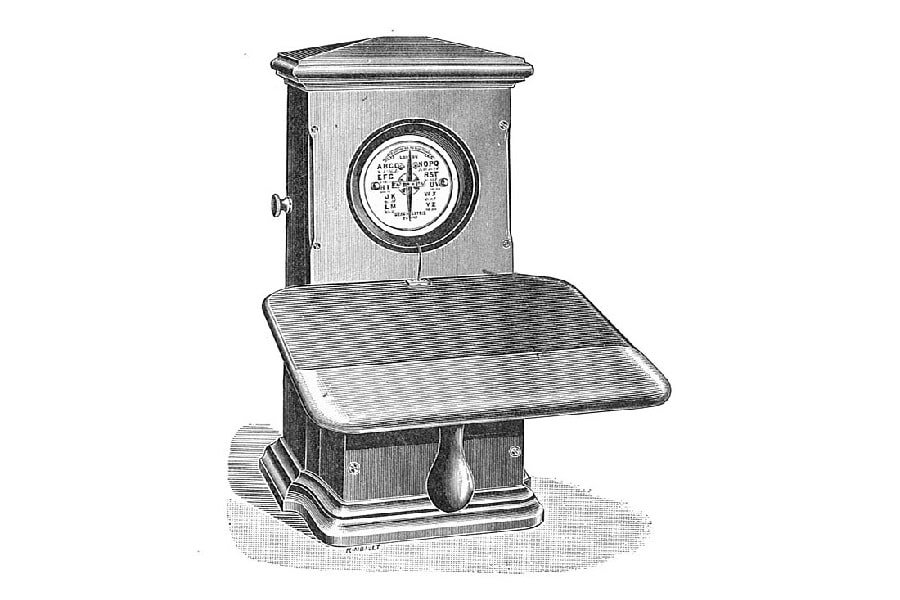
An electrical telegraph was almost like the first telephone service in the world. But, it did not send and receive calls. It communicated messages.
So, it was basically the world’s first SMS service.
The precursor to the cell phone in some ways, the electrical telegraph was a point-to-point messaging system.
On the sending side, switches would control the flow of current to telegraph wires. The receiving device would use an electromagnetic charge to form the representation of the sent information.
One of the first practical applications of electrical engineering, it existed in various forms. In its two most popular forms, it existed as a needle telegraph and as a telegraph sounder.
All of these technologies remained – to some extent – in commercial use until the electrical telephone came along.
Who Invented the Telephone?
People often begin the history of the telephone with Alexander Graham Bell. It’s not a bad place to start. But, what would you say if I told you that it was not Alexander Graham Bell who created the first telephone?
At least, not technically.
Quite often, tracking the original inventor of a new device can be quite tricky. The history of the telephone is certainly one such instance.
It has remained a controversial topic over the years, garnering much attention from historians and scholars. Books, research articles, and court cases have tried to solve this puzzle to no avail.
Alexander Graham Bell’s telephone was the first patented model of a series of similar inventions. It’s fine to call him the “father of the telephone,” but let us not forget others, who toiled their blood and sweat to push technology forward.
Antonio Meucci

The printing press was one of the greatest inventions in human history until the arrival of the cell phone . It served as the prime form of formal communication within a society. That changed with the arrival of telegraphs.
But, people had been sending and receiving letters for the longest of time.
One guy thought that paper was far too slow and inefficient. Why not develop a device that could get over these barriers? Such a device would be quicker and be able to communicate intonation, instead of implying it.
An Italian innovator, Antonio Meucci , had just this idea. He wanted to create a simpler and more efficient way of long-distance communication. So, he started working on developing a design for a talking telegraph. He is now credited with creating the first basic phone in 1849.
Charles Bourseul
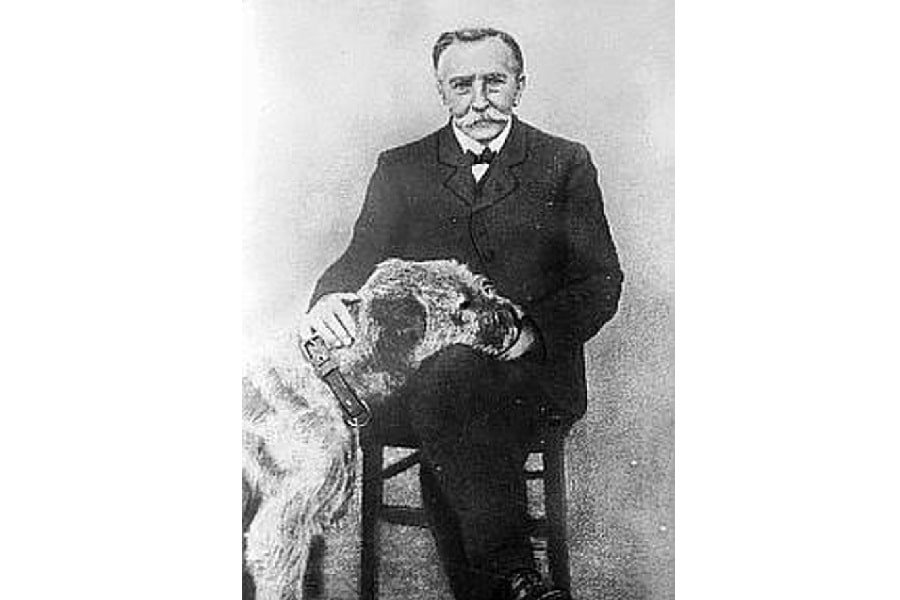
Born in Belgium and raised in France, Charles Boursel worked as an engineer for a telegraph company. He made improvements to existing models of the telegraph before deciding to experiment with electrical systems.
He was able to transmit speech electrically by creating an electromagnetic telephone. Unfortunately, his receiving device was unable to convert the electric signal back into clear, audible sounds.
He also wrote a memorandum on the transmission of human speech by using an electric current. He published the article in a Paris magazine. Meucci claimed his first attempt to make a telephone came shortly afterward.
Johann Phillip Reis

Phillip Reis was instrumental in the invention of the telephone. In 1861, he created a device that captured the sound and converted it into electrical impulses. These would, then, travel through wires and reach the receiver.
Reis called his microphone “the singing station” since he wanted to invent a device for broadcasting music. A patent dispute ensued in which Thomas Edison came out on top, despite having made the device after Reis.
Thomas Edison used the ideas provided by Reis to develop his carbon microphone. About Reis, he said :
The first inventor of a telephone was Phillip Reis of Germany [. . .]. The first person to publicly exhibit a telephone for transmission of articulate speech was A. G. Bell. The first practical commercial telephone for transmission of articulate speech was invented by myself. Telephones used throughout the world are mine and Bell’s. Mine is used for transmitting. Bell’s is used for receiving.
Thomas Edison
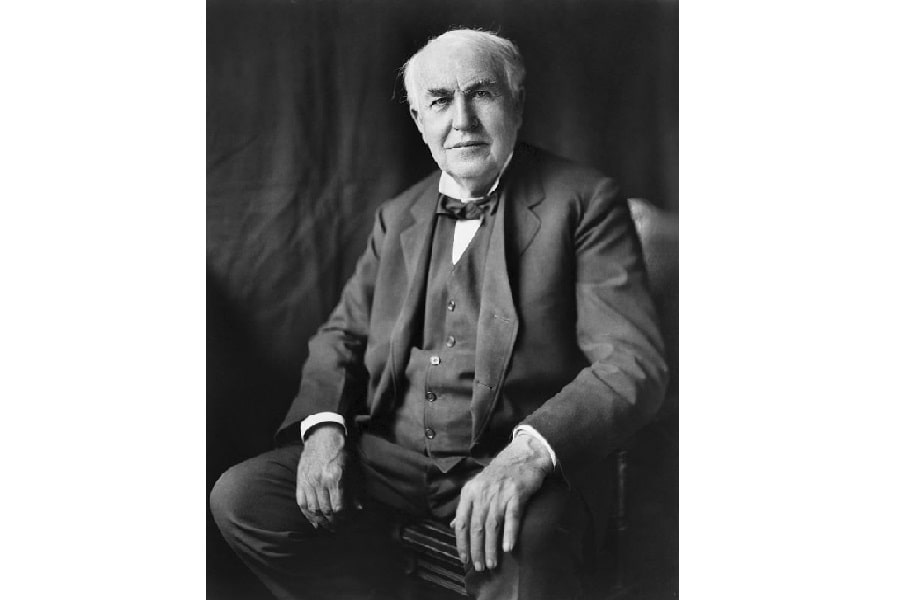
Thomas Edison is a popular name, known primarily for his contributions to introducing a lightbulb . But, Thomas was less of an inventor and more of an entrepreneur, who was often more interested in gathering novel things than inventing them.
For instance, his contributions to the electric light often spark much controversy when compared to the work of Nikola Tesla . But, like in his other inventions, he did add important flourishes to the final, practical product.
When it comes to the carbon microphone, he was experimenting with it at the same time when David Edward Hughes was working on transmitters and “the microphone effect” and Emile Berliner was working on a loose-contact transmitter. All three of them based their works on the study of Phillip Reis.
David Edward Hughes
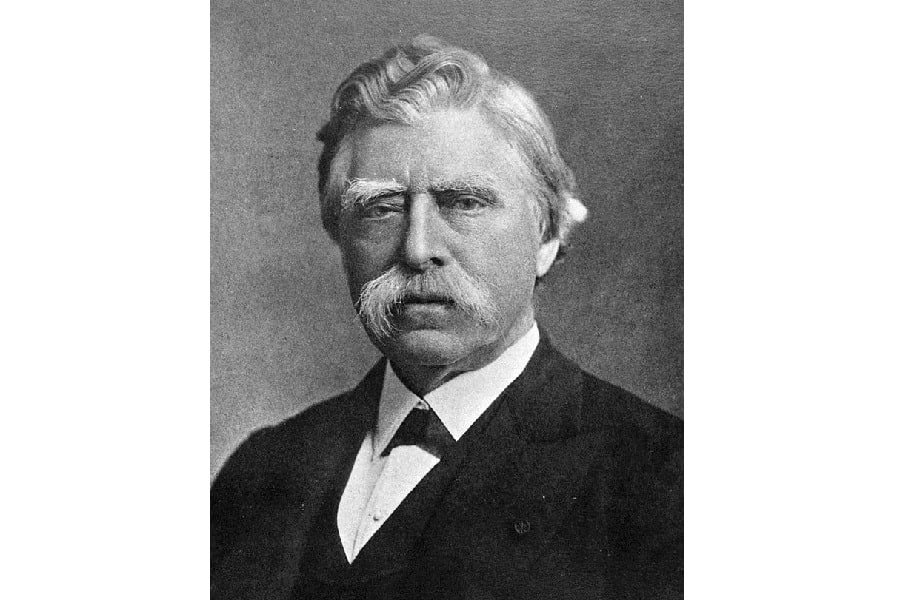
David Edward Hughes was the real force behind the invention of the carbon microphone, even though Edison took all the credit. Hughes had demonstrated his device to the members of the public and most people consider him the “real” inventor of the carbon microphone.
Hughes chose not to take out a patent. He wanted his gift to be a gift to the world. On the other side of the world, in the US, both Edison and Emile Berliner competed in a race for acquiring the patent.
When Edison won the patent, he was officially credited with the invention of the microphone, even though the word itself was coined by Hughes. The microphones we use today are direct heirs of the carbon microphone.
Elisha Gray

Before we get to Bell, here is another significant name to add to the list: Elisha Gray.
Elisha Grey was the co-founder of the Western Electric Manufacturing Company and is remembered for the development of the telephone prototype in the late 1800s. This was a few years after Alexander Graham Bell obtained the patent for telephone technology.
Here’s the catch: there have been several allegations that Bell stole the idea of a liquid transmitter from Elisha, who had been experimenting with and using them for years.
This entire matter is shrouded in controversy and some people claim that Elisha Grey should be credited for the invention of the telephone. After many legal battles, courts have mostly favored Bell.
Alexander Graham Bell
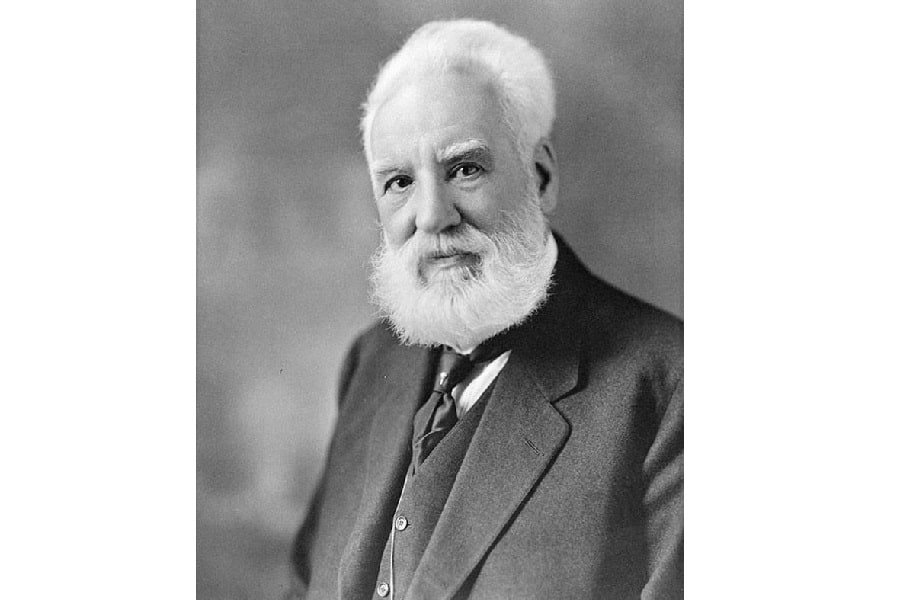
And, so we finally get to Alexander Graham Bell, the man who went to the patent office and, supposedly, influenced the people there to grant him the patent before others.
Bell patented the phone as an “apparatus for transmitting vocal or other sounds telegraphically.”
Both Antonio Meucci and Phillip Reis were the foremost pioneers but they were unable to make a complete device that performed in all practical arenas. Alexander Graham Bell’s device, on the other hand, could be seen as the first practical telephone.
The claims and counterclaims regarding the invention of early telephones abound, only the patents of Bell and Edison are commercially decisive. The zeitgeist flowers Bell with all the praise.
The telephone started evolving from this point forward. All forms of the modern telephone can be traced back to the inventions of all the aforementioned gentlemen.
When Was the Telephone Invented?
It depends on what you consider the “invention of the telephone.”
The Analog Devices
The earliest form of the mechanical telephone, the one invented by Robert Hooke, was made in 1667. In 1672, Francis Bacon suggested the use of pipes for transmitting sound. In 1782, a French monk, Dom Gauthey, started experimenting with Francis’ idea.
The First Telegraphs

The first working telegraph was made in 1816 by an English inventor, Francis Ronalds. Baron Schilling made an electromagnetic telegraph in 1832, followed by Carl Friedrich Gauss and Wilhelm Weber in 1883, who made a different electromagnetic telegraph.
The First Telephones
By improving all these devices, we eventually got to the telephone in the mid-19th century. Antonio Meucci constructed his telephone-like device during the years 1849-1854. 1854 is also the year in which Charles Bourseul wrote his memorandum on the transmission of sound.
Reis constructed his first prototype in the year 1862, a few years before Bell would perfect the design. His work was presented in the United States in 1872, where it started to pique the interest of entrepreneurs and engineers.
David Edward Hughes invented his carbon microphone in 1878 in England . Thomas Edison and Emile Berliner followed suit in the US. Interestingly, Edison was awarded the patent for the microphone in 1877, but Hughes had demonstrated his device much earlier but took the time to work out the kinks.
Elisha Gray made his telephone in 1876, the same year as Alexander Graham Bell. Here is where the story gets interesting.
Gray had signed the documents, had them notarized, and submitted them to the US Patent Office on the 14th of February, 1876. The very same morning, Bell’s lawyer submitted a patent application. Whose application arrived first was contested. Gray believed that his application had reached the offices before Bell’s application.

The Patent Drama
According to one account, Bell’s lawyer found out about Gray’s device and his lawyer’s intention of delivering the application on the morning of the 14th. He then added similar claims to Bell’s application and delivered it to the office. It reached the office at noon. Gray’s application had made its way to the office in the morning.
Well then, how was Bell awarded the patent?
Bell’s lawyer hustled to get the application to submit the application on the same day, so he could later claim that it had arrived first – since the record would show that both applications had arrived on the same day. Bell was away during this period of time and in all probability, could not have known that his application had been filed.
The examiner was annoyed at the issue and suspended Bell’s application for 90 days. During this time, Bell was informed of the situation and he resumed his work. After the mess of all the legalities and technicalities, the examiner noted that:
. . . while Gray was undoubtedly the first to conceive of and disclose the [variable resistance] invention, as in his caveat of February 14, 1876, his failure to take any action amounting to completion until others had demonstrated the utility of the invention deprives him of the right to have it considered.
The entire incident did not sit well with Gray, who challenged Bell’s claims. Two years of litigation yielded nothing but disappointment for him as Bell was awarded the rights to the telephone. Alexander Graham Bell was the official inventor of the telephone.
The First Telephone Call
The first telephone call was made by Alexander Graham Bell in 1876 when he said the words:
“Mr [Thomas] Watson, come here. I want to see you.”

Evolution of the Telephone
A mobile phone is a cool little gadget, but it took a long time to make the first cellular phone. Charting the progress from electrical telephones to cell phones is certainly no easy task. But, let’s try it, anyway.
Get ready for a lot of firsts as we look at some of the most important innovations along the way:
The First Permanent Outdoor Telephone Wire
The first permanent outdoor telephone wire was placed in Nevada County, California in 1877. It was 97km long and was operated by the Ridge Telephone Company.
Along with the rise of the commercial telephone service phenomenon, outdoor wiring helped the telephone network become increasingly dense.
The Arrival of the Telephone Service
By the time, the telephone was available as a product, electrical telegraphs were already a common phenomenon. Stock exchanges, governmental institutions, large corporations, and the homes of the elite class already employed and used them.
The underlying structure and network of the telegraph systems allowed the telephone networks to easily map themselves according to the existing schema.
Telephones had already arrived in the market and were being used. But, they had to be connected directly, which of course, restricted their use in a major fashion. All of this had to change, and change it did, with the arrival of the telephone exchange.
By 1877, Friedrichsberg near Berlin had a commercial telephone company, the first one of its kind.
The Telephone Exchange
The telephone exchange was a big deal at the time. It was single-handedly responsible for the commercial rise of telephone technology.
A telephone exchange connects individual subscriber lines, enabling users to connect with each other. It was a web of sorts: all paths led here. Calls would arrive here and the operators would forward them to the desired receiver.
This idea was the brainchild of a Hungarian engineer, Tivadar Puskas. When Bell invented the telephone or claimed to have done so, Puskas was working on his idea of an exchange.
“Tivadar Puskas was the first person to suggest the idea of a telephone exchange,” claimed Thomas Edison, with whom Puskas started working shortly afterward.
Based on Puskas’ ideas, the Bell Telephone Company built the first exchange in 1877 – thanks to George W. Coy, Herrick P. Frost, and Walter Lewis -, and Puskas set up one in Paris, a couple of years later. The former is often considered the first telephone exchange in the world. Before you know it, commercial telephone service became a thing.
Puskas later developed the technology for “Telephone News Service” and was awarded a patent in 1892. His model was the precursor to the radio .

The First Transcontinental Telephone Line
The first long-distance call took place in 1915. A transcontinental telephone line was placed for this purpose between New York City and San Francisco.
Graham Bell placed the call from 15 Dey Street and it was received at 333 Grant Avenue by his former assistant and colleague, Thomas Watson.
The transcontinental telephone line linked the Atlantic seaboard with the West Coast. It is generally referred to as the New York-San Francisco line.
The First Transatlantic Telephone Line
Transatlantic telephone cables were placed to take the idea of a local telephone network to the global level.
This was, by no means, the first remote transatlantic communication. Transatlantic telegraphs had existed before. But, once the transatlantic telephone cables were installed, there was no need for telegraphs anymore.
The first transatlantic call took place between the President of the company now known as AT&T, Walter S. Gifford, and the head of the British General Post Office, Sir Evelyn P. Murray.
The Humble Beginnings of the Mobile Phone
The cell phone is a fairly modern invention, but its roots go back to the early years of the 20th century, the first mobile phone service started appearing in German railway systems. In 1924, Zugtelephonie AG was founded and they started supplying telephone equipment for use in trains. By 1926, mobile telephone systems were being used by Deutsche Reichsbahn in Germany.
Instead of hampering the progress of mobile technology, the Second World War quickened it. With the increased military urgency, there were many advances in mobile communications. Gradually, military vehicles started using two-way radios to coordinate their movements and plans.
After the war, vehicles like railroad trains, taxicabs, and police cruisers started using two-way mobile communication systems. Companies in US and Europe were offering these large systems. They were large, power-hungry devices that were not exactly practical.
From here, small advances would take us to the inevitable launch of the first cell phone.
Mobile Phone Networks
AT&T’s Bell Labs introduced a mobile service in 1946, which was commercialized by 1949 as the Mobile Telephone Service.
The First Handheld Mobile Phone

In 1973, Motorola built the first cell phone. Martin Cooper and his team beat Bell Labs to the punch and stepped into a news conference to unveil the product. The product would go on to revolutionize communication in the next couple of decades.
The DynaTAC 8000x, although demonstrated earlier, came out a decade later and the rest is history.
We could go on to discuss digital cordless phones, the first tri-band GSM phone, the first camera phone, the first touchscreen phone, and several other firsts in the world of cellular phones, such as the first Android phone and the first iPhone .
The history of the telephone is a messy web of separate incidents and narratives, all of which happen to intersect and coincide in a unique fashion. From the controversy surrounding the first telephone to the development of the telephone network, all offer an insight into the minds of the pioneers who helped shape the modern understanding of our world.
How to Cite this Article
There are three different ways you can cite this article.
1. To cite this article in an academic-style article or paper , use:
<a href=" https://historycooperative.org/history-of-phones/ ">The Complete History of Phones from the Last 500 Years</a>
Leave a Comment Cancel reply
From “brick” to smartphone: the evolution of the mobile phone
- FEATURES POSTERMINARIES
- Published: 05 March 2021
- Volume 46 , pages 287–288, ( 2021 )
Cite this article

- Steve Moss 1
1 Altmetric
Explore all metrics
Avoid common mistakes on your manuscript.
Telephony began in the 1870s with the invention of the telephone. Alexander Graham Bell filed a patent for his version of the telephone at the US Patent Office in Washington, DC, on February 14, 1876, just a few hours before his competitor Elisha Gray filed his patent based upon independent work. 1 Since then, materials research has pushed this field of technology involving the development, application, and deployment of telecommunication services, particularly in recent years.
The proliferation of telephones did not make a great overnight leap. In fact, as late as 1950, only 62% of American households contained a telephone, 2 and that number had been significantly smaller before World War II. Most communications were by telegram, letter, or through face-to-face discussions. One significant hindrance to communication was natural disasters, which often led to long periods of no information between family and friends.
On the evening of January 3, 1949, a devastating tornado struck the small town of Warren, Ark. 3 The tornado left more than 50 dead and more than 300 injured. My dad’s parents, brother, sister-in-law, niece, and nephew, as well as many friends, lived in Warren at that time and were affected. Telephone lines were destroyed. My parents and I lived far away and had no way to get in contact with them. More than a week passed before we received word that they were okay.
My father later accepted a faculty position at Arkansas A&M College in Monticello, 16 miles from Warren, to be closer to his family. When we moved to a farm near the campus, our first telephone line was a party line, which consisted of a single channel shared by many people. This offered little in the way of privacy, as others outside of your household could listen to conversations. We eventually upgraded to a private landline. The phone was located in a central part of the house, and the cord was only a few feet long, which meant that you were essentially tethered to that spot when making or answering a call, not ideal for any teenager craving privacy.
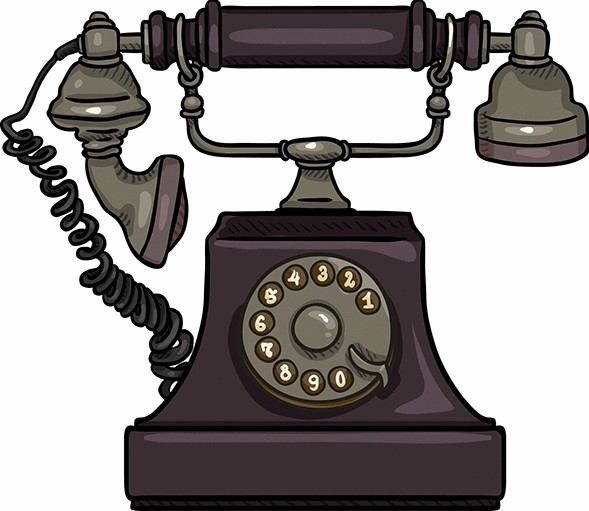
People then didn’t have the luxury of cell phones, and instead often used pay phones by inserting money or calling collect. Jim Croce has a wonderful song, “Operator,” 4 about an unsuccessful attempt to connect with some old friends. I often wonder if younger people understand the significance of the lyrics, including the phrase “You can keep the dime.”
Today, humanity is more connected than ever through the use of cell phones. However, mobile phones didn’t start in their current, sleek style. The first mobile phone by Motorola in 1983 5 was so big and heavy that it was nicknamed “the brick.” Current phones are significantly more lightweight and compact and have the capability to text, email, access social media, access the Internet, and much more.

According to recent surveys, 75% of the world’s population owns a cell phone. 6 , 7 Surveys in 2019 indicated that there were 5.11 billion unique mobile phone users, and that 2.71 billion of them used smartphones. People from China (> 782 million users) and India (> 386 million users) are the largest consumers of smartphones, followed by the United States (> 235 million users).
If you search for technological advances that facilitated progress to the current state of cell phone technology, you will find lists that include the Internet, global positioning systems, touch screens, cameras, high-speed modems, displays, batteries, and a host of other materials and technologies. 8 , 9
The computers that drive recent smartphones have 64-bit architectures. 10 , 11 They are usually fabricated as a system-on-a-chip and include multiple cores and extra features, such as neural engines and embedded motion coprocessors. They contain cameras with more than 10 megapixels and multi-element lens systems and include zoom capabilities and two-axis stabilization. The phones support a wide variety of standard communication protocols, including accessibility features for those who wear hearing aids. Recent smartphone microprocessors have been built with fin field-effect transistors (finFETs) 12 manufactured at the 10 nm, 7 nm, and 5 nm processing scales. They also include a range of sensors, including for facial identification, a barometer, a three-axis gyro, an accelerometer, a proximity sensor, an ambient light sensor, a Hall sensor, and a RGB light sensor. 10 , 11
These systems are also designed to take advantage of fifth-generation (5G) cell phone networks with advantages in bandwidth and data rates (eventually up to 10 Gbps). 13
Integrating even a fraction of these capabilities into the early Motorola mobile phone would have likely expanded the size, weight, and power requirements well beyond what one person could have easily carried. (As I write this, an image of a famous body-builder, Arnold Schwarzenegger, struggling to lift this enhanced “brick” popped into my head, as he was trailed by a large generator on wheels to power the phone.) This does not factor in the fact that many of these technologies did not exist at the time.
Microelectronics has evolved through a range of technologies and materials developments over the years 14 , 15 that have affected transistors (bipolar junction transistors, various metal–oxide–semiconductor field-effect transistors, including finFETs), dielectrics (thermal oxides, high- k dielectrics), metallization (aluminum, polysilicon, copper, tungsten vias), high levels of integration, including multilayer metallization, and integration of billions of transistors per chip. Fabrication of modern microchips involves many hundreds of process steps that have to be performed within narrow tolerances. It is remarkable that these fabrication lines yield in numbers high enough to be economically viable. If any step falls outside of the tolerances, then yield can fall catastrophically. This would kick off an investigation to determine the root cause(s) of the problem and can shut down fabrication lines for long periods of time—an expensive proposition. Developing these technologies and the processes that allow them to be inserted into high-yield fabrication lines have occupied hordes of materials researchers for decades.
I could write similar discussions of materials advances in batteries, displays, touch screens, and camera systems that have relied on similar hordes of materials researchers. However, I’m out of space for this article, so those stories will have to wait until another time.
The features described, the ease of carrying modern cell phones, and their economic affordability are driving the surge in worldwide usage. Access to information is only as good as the information. We are constantly bombarded with inaccurate information as well as disinformation. Filtering all of that can be difficult and time consuming. Instantaneous access to information using cell phone and other electronic technologies provides the unwary with an opportunity to make huge mistakes quickly.
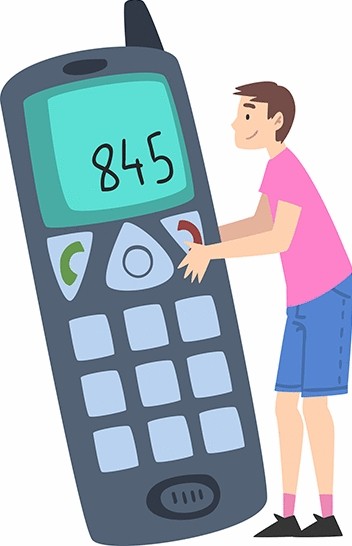
The use of landline phones reached a peak in the 2000s. Now they are down to around 40% of American households and declining. 16 I am one of those neo-Luddites who has chosen to keep my landline. I find that, for now, it gives me some comfort to have it available.
Warts and all, the proliferation of cell phone systems is good. Widespread outages due to local events are unlikely to destroy all cell towers in a local community. Therefore, people are likely to maintain some capability for communication, even if impacted by tornados such as the one on January 3, 1949, in Warren, Ark.
The invention of the telephone - Ericsson
https://www.statista.com/statistics/189959/housing-units-with-telephones-in-the-united-states-since-1920/
S. Beitler, A.R. Warren, Tornado destroys towns. GenDisasters (1949); http://www.gendisasters.com/arkansas/11233/warren-ar-tornado-destroys-towns-jan-1949
Operator (That's Not the Way It Feels) - Wikipedia
S. Wolpin, The first cellphone went on sale 30 years ago for $4,000. Mashable (2014); https://mashable.com/2014/03/13/first-cellphone-on-sale/
75% of the world's population owns a cell phone - PhoneArena
D. Metev, 39+ smartphone statistics you should know in 2020, Review 42 (2020); 39+ smartphone statistics you should know in 2020 (review42.com)
J. Gold, 11 tech breakthroughs that led to today’s smartphones. Computerworld (2017), https://www.computerworld.com/article/3222855/11-tech-breakthroughs-that-led-to-todays-smartphones.html
https://www.sciencemuseum.org.uk/objects-and-stories/computer-your-pocket-rise-smartphones
Apple iPhone 12 Pro Max - Full phone specifications ( gsmarena.com )
Specs | Samsung Galaxy S21 5G, S21+ 5G and S21 Ultra 5G | The Official Samsung Galaxy Site
https://en.wikipedia.org/wiki/FinFET#:~:text=A%20fin%20field%2Deffect%20transistor,forming%20a%20double%20gate%20structure
https://en.wikipedia.org/wiki/5G
B. Davari, R.H. Dennard, G.G. Shahidi, CMOS scaling for high performance and low power-the next ten years. Proc. IEEE 83 (4), 595 (1995)
Article Google Scholar
D.M. Fleetwood, Radiation effects in a post-Moore world. 2020 IEEE Nuclear & Space Radiation Effects Conference Short Course , K.F. Galloway, Ed. (2020), chapter I, pp. 1–81
E.K. Lieser, Study: only 40 percent of U.S. households have a landline. The National Interest (2020), https://nationalinterest.org/blog/buzz/study-only-40-percent-us-households-have-landline-135212#:~:text=Today%2C%20that%20figure%20has%20plummeted,households%20utilized%20only%20wireless%20service
Download references
Author information
Authors and affiliations.
Cambridge, UK
You can also search for this author in PubMed Google Scholar
Rights and permissions
Reprints and permissions
About this article
Moss, S. From “brick” to smartphone: the evolution of the mobile phone. MRS Bulletin 46 , 287–288 (2021). https://doi.org/10.1557/s43577-021-00067-7
Download citation
Published : 05 March 2021
Issue Date : March 2021
DOI : https://doi.org/10.1557/s43577-021-00067-7
Share this article
Anyone you share the following link with will be able to read this content:
Sorry, a shareable link is not currently available for this article.
Provided by the Springer Nature SharedIt content-sharing initiative
- Find a journal
- Publish with us
- Track your research
The First Mobile Phone Call Was Made 75 Years Ago
The evolution of the cell phone illustrates what it takes for technologies to go from breakthrough to big time
Daniel Bliss, The Conversation
/https://tf-cmsv2-smithsonianmag-media.s3.amazonaws.com/filer/95/64/9564d28d-77ff-42fb-b20d-5b3bee6ba80f/car_phone.jpg)
I have a cell phone built into my watch. People now take this type of technology for granted, but not so long ago it was firmly in the realm of science fiction. The transition from fantasy to reality was far from the flip of a switch. The amount of time, money, talent and effort required to put a telephone on my wrist spanned far beyond any one product development cycle.
The people who crossed a wristwatch with a cell phone worked hard for several years to make it happen, but technology development really occurs on a timescale of decades. While the last steps of technological development capture headlines, it takes thousands of scientists and engineers working for decades on myriad technologies to get to the point where blockbuster products begin to capture the public’s imagination.
The first mobile phone service, for 80-pound telephones installed in cars, was demonstrated on June 17, 1946 , 75 years ago. The service was only available in major cities and highway corridors and was aimed at companies rather than individuals. The equipment filled much of a car’s trunk, and subscribers made calls by picking up the handset and speaking to a switchboard operator. By 1948, the service had 5,000 customers .

The first handheld mobile phone was demonstrated in 1973 , nearly three decades after the introduction of the first mobile phone service. It was nearly three decades after that before half the U.S. population had a mobile phone .
Big history in small packages
As an electrical engineer , I know that today’s mobile phone technology has a remarkable number of components, each with a long development path. The phone has antennas and electronics that allow signals to be transmitted and received. It has a specialized computer processor that uses advanced algorithms to convert information to signals that can be transmitted over the air. These algorithms have hundreds of component algorithms. Each of these pieces of technology and many more have development histories that span decades.
A common thread running through the evolution of virtually all electronic technologies is miniaturization . The radio transmitters, computer processors and batteries at the heart of your cellphone are the descendants of generations of these technologies that grew successively smaller and lighter.
The phone itself would not be of much use without cellular base stations and all the network infrastructure that is behind them. The first mobile phone services used small numbers of large radio towers, which meant that all the subscribers in a big city shared one central base station. This was not a recipe for universal mobile phone service.
Engineers began working on a concept to overcome this problem at about the time the first mobile phone services went live, and it took nearly four decades to roll out the first cellular phone service in 1983. Cellular service involves interconnected networks of smaller radio transceivers that hand off moving callers from one transceiver to another.


Military necessity
Your cell phone is a result of over a hundred years of commercial and government investment in research and development in all of its components and related technologies. A significant portion of the cutting-edge development has been funded by the military.
A major impetus for developing mobile wireless technologies was the need during World War II for troops to communicate on the move in the field. The SRC-536 Handie-Talkie was developed by the predecessor to Motorola Corporation and used by the U.S. Army in the war. The Handie-Talkie was a two-way radio that was small enough to be held in one hand and resembled a telephone. Motorola went on to become one of the major manufacturers of cell phones.
The story of military investment in technology becoming game-changing commercial products and services has been repeated again and again. Famously, the Defense Advanced Research Projects Agency developed the technologies behind the internet and speech recognition. But DARPA also made enabling investments in advanced communications algorithms, processor technology, electronics miniaturization and many other aspects of your phone.
Looking forward
By realizing that it takes many decades of research and investment to develop each generation of technology, it’s possible to get a sense of what might be coming. Today’s communications technologies – 5G, WiFi, Bluetooth, and so on – are fixed standards, meaning they are each designed for a single purpose. But over the last 30 years, the Department of Defense and corporations have been investing in technologies that are more capable and flexible.
Your phone of the near future might not only fluidly signal in ways that are more efficient, enable longer ranges or higher data rates, or last significantly longer on a charge, it might also use that radiofrequency energy to perform other functions. For example, your communications signal could also be used as a radar signal to track your hand gestures to control your phone, measure the size of a room, or even monitor your heart rate to predict cardiac distress.
It is always difficult to predict where technology will go, but I can guarantee that future technology will build on decades upon decades of research and development.
Daniel Bliss is a professor of electrical engineering at Arizona State University.
This article is republished from The Conversation under a Creative Commons license. Read the original article .
Get the latest stories in your inbox every weekday.

Essay on Evolution Of Cell Phones
Students are often asked to write an essay on Evolution Of Cell Phones in their schools and colleges. And if you’re also looking for the same, we have created 100-word, 250-word, and 500-word essays on the topic.
Let’s take a look…
100 Words Essay on Evolution Of Cell Phones
The beginning of cell phones.
Long ago, phones were stuck in buildings, tied down by wires. Then, in the 1970s, the first cell phones arrived. They were big and heavy, not at all like the small ones we have now. People could walk and talk with them for the first time.
Getting Smaller and Smarter
As years passed, cell phones became smaller and did more than just calls. By the 1990s, they could send messages. Soon, they had cameras, and you could play simple games on them, like the famous snake game.
Smartphones Change Everything
Around 2007, smartphones were introduced. These were like tiny computers in your pocket. They could browse the internet, play videos, and use lots of different apps for games, learning, and even talking face-to-face with video.
Today and Tomorrow
Today’s cell phones are very powerful and can do almost anything. They keep getting better, with clearer cameras and the ability to understand what you say. The future might bring even more changes, like folding screens or new ways to charge them.
250 Words Essay on Evolution Of Cell Phones
The start of cell phones.
Long ago, phones could only be found in homes and offices, stuck to one place. Then, in the 1970s, the first cell phones came out. They were very big, heavy, and only made for talking. Carrying them around was hard because they were almost as heavy as a bunch of books.
As years passed, cell phones began to shrink in size. By the 1990s, they were small enough to fit in pockets and came with a game called Snake that many loved. Text messages also became a new way to chat, making it easier to send quick notes without calling.
Touch Screens and the Internet
The biggest change came when touch screens were introduced. The first iPhone in 2007 showed that phones could be like tiny computers. People could now touch their screens to make calls, play games, and even go on the Internet. This was a huge step that made phones much more than just for talking.
Modern Cell Phones
Today, cell phones are very powerful. They have cameras that take pictures like a real camera, maps that help us not get lost, and apps for almost anything. They can answer questions, play movies, and let us talk to friends with video. Cell phones have become a big part of our lives, helping us do many things every day.
In conclusion, cell phones have changed a lot from the big bricks they once were. They’ve become smaller, smarter, and a tool that can do so much. It’s exciting to think about what they will be able to do in the future.
500 Words Essay on Evolution Of Cell Phones
Once, phones were stuck to walls, sitting in homes and shops. Then, an amazing change happened. The first cell phone came out in the 1970s. It was big and heavy, like carrying a brick. People could talk without wires anywhere they could find a signal. This was the start of a big change in how we talk to each other.
In the 1980s and 1990s, cell phones started to get smaller. They also became lighter and easier to carry. Batteries got better, and phones could work for a longer time without needing to charge. Screens were small and only showed a few lines of text. Most phones could only make calls and send simple text messages.
Phones Turn into Computers
Around the year 2000, cell phones began to do more. They got color screens and cameras. People could take pictures and send them to friends. Phones could play music and games. They became like tiny computers. This was when the name “smartphone” was born. These phones could go on the internet, send emails, and download apps.
Touch Screens Take Over
A big moment came in 2007 when the first iPhone was released. It had a big screen you could touch to control everything. There were no more buttons for each number. You could type on a screen keyboard. This change made it easier to use the phone for all kinds of things. Many companies started making phones like this, with big touch screens.
Apps Change the Game
With touch screens, apps became very important. Apps are like little programs for your phone. They let you do all sorts of things, like playing games, learning, shopping, or watching videos. The app stores have millions of apps now. This made smartphones even more useful and fun.
Phones Today
Today, cell phones are very powerful. They are as strong as some computers. You can talk, text, take pictures, make videos, and do lots of other things. They have big, clear screens and can connect to the internet very fast. Some can even fold or have more than one screen!
The Future of Cell Phones
No one knows exactly what cell phones will be like in the future. They might bend, fold, or change shape. Maybe they will project images into the air or stick to our wrists like a watch. One thing is sure: they will keep getting better and will do even more things for us.
Cell phones have come a long way since they first appeared. From big bricks to pocket-sized computers, they have changed a lot. They help us talk to friends, find information, and have fun. It’s exciting to think about what they will do next!
That’s it! I hope the essay helped you.
If you’re looking for more, here are essays on other interesting topics:
- Essay on Evolution And Creation
- Essay on Evolution
- Essay on Evil
Apart from these, you can look at all the essays by clicking here .
Happy studying!
Leave a Reply Cancel reply
Your email address will not be published. Required fields are marked *
Save my name, email, and website in this browser for the next time I comment.

MIT Technology Review
- Newsletters
Smartphone innovation in the third decade of the 21st century
Provided by Tecno Mobile
2019 was a year of triumphs and challenges for the smartphone industry. It was a time when manufacturers encountered an almost continual decline of global shipments—but it also marked the introduction of sophisticated new features such as foldable screens and long-awaited 5G technology. Though far from mature, these early drafts are helping establish a solid foundation and direction for smartphone technology in 2020.
From the day they debuted, mobile phones have been evolving. The world has now entered an era of cell phones with superior functions. Over the past 20 years, the following aspects of mobile devices have undergone significant changes:
Style and appearance. One of the most observable changes is the look and feel of mobile phones. They have morphed from their original candy-bar form to the iconic flip phone, which enjoyed great popularity for a long time. Then the slide phone took its place, thanks to its modern design and convenient operation. Next was the touchscreen phone, the most widely available style in the current smartphone market.

Size. Like computers, when mobile phones first came out, they were big and bulky; today they’re small and lightweight. The goal throughout their evolution was to meet the needs and expectations of users—to be more portable and user-friendly.
Function. Of course, mobile phones, starting way back with telephones, were invented for communication. In the past, phones played a single role: they allowed people to make calls. Thanks to the development of networks, technology, and social needs, phones today let users do much more—send and receive text messages and emails, take photos and videos, access the internet, listen to music, and play games, among many other functions. That’s not to mention artificial intelligence (AI) technology, steadily making its way into mobile phones and allowing for things like human-machine interaction—“Alexa, add milk and eggs to my shopping list.”
Image/camera technology. The photography function is one of the most remarkable changes in modern smartphones. In the beginning, most smartphones had a single, rear-facing camera for photo shooting. Then the smartphone camera came of age: it moved to the screen display, facing the user, then adding video, high-definition, night-mode, and anti-shake technology. All these features together make the photography function the most valuable addition to the modern smartphone.

Stepping into 2020, here are six trends that users can expect to see in the latest generation of smartphones:
More screen. Most smartphone companies have introduced phones with full screens. There’s no denying that full screens have advantages—they give the smartphone an outstanding screen display and stunning visual effects. The full-screen design, to some extent, drives creative development in the smartphone industry.
One important feature of full-screen displays over the past few years is the notch—the black cutout, typically rectangular, at the top of the phone that houses sensors, speaker, and the phone’s front-facing camera. Two new designs attempting to maximize screen space—the water-drop notch and no-notch displays—will most likely be the dominant smartphone design in 2020. Compared with the more prominent monobrow notch, the water-drop notch display takes up less room and can have a screen-to-body ratio of 85%. The no-notch display is new to the market and has the highest screen-to-body ratio, in some phones thanks to a pop-up camera at the top of the phone.
Mobile photography. Super-high-definition cameras are a goal that smartphone companies will continue to chase after, as social media becomes an increasingly important part of modern life. People are spending more time on social media than ever before. Not only do they send and receive written messages through platforms such as Facebook and Twitter, they are also using smartphone cameras to capture and share important life moments, hence the demand for ever-higher photo quality.
In the second half of 2019, smartphones with 64-megapixel cameras were released to the market. This high-res imaging technology will be a big selling point in 2020, with 80% of smartphone companies putting out smartphones fitted with these cameras. The demand for better mobile photography dovetails with the introduction of 5G technology, which allows more data to be transmitted over wireless networks.
Foldable phones. 2019’s CES show in Las Vegas highlighted that foldable technology is on the rise, particularly foldable personal computers. Limited by cost and technology, foldable smartphones have not been widely accepted by consumers. However, with the potential for an even greater screen size, an evolution back towards foldable phones may be likely. Smartphone manufacturers are continuing to innovate around foldable models and the industry expects to see new breakthroughs in the decade ahead.
Artificial intelligence. AI technology will significantly enhance the user experience, improving smartphones’ sensing, analyzing, and interacting functionality. For example, with on-device sensors such as Wi-Fi, Bluetooth, and Global Positioning System technology, a smartphone can create a rich, offline profile of its user and even foresee his or her needs, then make suggestions that will help fulfill them. And through machine-human interaction, the smartphone can collect feedback, continually correcting mistakes so that it’s in lockstep with the user.
As AI gets infused into smartphones in 2020 and beyond, it will also help improve photos, battery life, and cybersecurity.
5G. 2020 is considered the “first year” of 5G communication, which many analysts and observers predict will invigorate and restructure the telecoms industry. 5G technology promises to vastly boost the speed and widen the coverage of wireless networks, and its advent is a huge opportunity for smartphone companies, with hundreds of millions of 5G phones expected to ship in 2020.
Processors. There is still room for improving mobile processors in 2020, to keep pace with smartphone industry trends. More powerful processors mean improved graphics performance. The success of the Nintendo Switch video game console shows that smartphones with high-quality visuals are popular among users. Moreover, modern mobile chips that can support a smartphone’s camera, video, audio, gesture recognition, and other functionality have become mainstream, overtaking simple processor design. Smartphones this year will also see built-in 5G connectivity.
It’s time to retire the term “user”
The proliferation of AI means we need a new word.
- Taylor Majewski archive page
Modernizing data with strategic purpose
Data strategies and modernization initiatives misaligned with the overall business strategy—or too narrowly focused on AI—leave substantial business value on the table.
- MIT Technology Review Insights archive page
How ASML took over the chipmaking chessboard
MIT Technology Review sat down with outgoing CTO Martin van den Brink to talk about the company’s rise to dominance and the life and death of Moore’s Law.
- Mat Honan archive page
- James O'Donnell archive page
Why it’s so hard for China’s chip industry to become self-sufficient
Chip companies from the US and China are developing new materials to reduce reliance on a Japanese monopoly. It won’t be easy.
- Zeyi Yang archive page
Stay connected
Get the latest updates from mit technology review.
Discover special offers, top stories, upcoming events, and more.
Thank you for submitting your email!
It looks like something went wrong.
We’re having trouble saving your preferences. Try refreshing this page and updating them one more time. If you continue to get this message, reach out to us at [email protected] with a list of newsletters you’d like to receive.
Evolution of the
Mobile phone.
From simple to smart, mobile phones have transformed dramatically to become information and communication hubs fundamental to modern life. But how did they get to be this advanced? Scroll through the timeline to see how and when phone technology evolved.

Image: DynaTAC 8000X, 1983
1983 - 1990
The first ever portable mobile phone.
In 1983 the world got the first ever portable mobile phone in the shape of the Motorola DynaTAC 8000X. It cost an eye-watering $4000 USD and was a huge status symbol at the time. Two years later the first mobile phone call on UK soil was made, the then Vodafone Chairman Sir Ernest Harrison, the lucky recipient. In 1989 Motorola followed up the DynaTAC with the 9800X or MicroTAC, it came with a fold down keyboard cover and set the standard for the flip phone form factor seen throughout the 90's.
Features From This Era
1991 - 1994, dawn of consumer handsets.
GSM first launched in Europe 1991 with the Orbitel TPU 900 first to market, but it wasn't until 1992 that mobiles were no longer restricted to business use. Mass production paved the way for cost-effective consumer handsets with digital displays. Nokia was one of the first to take advantage of this transition, with the Nokia 1011 arriving that year.

Image: Nokia 1011, 1992

Image: Siemens S10, 1997
1995 – 1998
A splash of colour.
Although it only offered four colours, the Siemens S10 brought mobile phone displays to life for the first time in 1997. The same year Hagenuk launched the GlobalHandy, the first device without an external aerial. Customisation also kicked off in a big way with Ericcson offering swappable coloured front keyboard panels. The following year Nokia launched a range of ‘Xpress-on’ interchangeable covers on the 5100 series, making it the first fashion orientated phone.
- Vibrate Alerts
1999 – 2002
Growth of the feature phone.
1999 saw Nokia unveil the 7110 which was the first device to take advantage of WAP (a means of accessing information over a mobile wireless network).
A year later Sharp launched the world's very first camera phone, the J-SH04. It was only available in Japan but signalled the start of the public’s obsession with phone photography. However, it wasn’t until 2002 and the release of the Sony Ericsson T68i and its clip-on camera, that western markets started to take an interest in the camera phone.
- Tri-Band Roaming
- Polyphonic Ringtones
- Memory Card

Image: Sony Ericsson T68i, 2002

Image: BlackBerry Pearl 8100, 2006
2003 – 2006
Mobile data revolution.
The implementation of 3G took download speeds up to 2MBS in March 2003 with "3" the first to offer the service in the UK. RIM brought mobile email to the masses with its range of popular BlackBerry devices like the 8100 Pearl. The advent of front facing cameras in 2003 on devices such as the Sony Ericsson Z1010 meant video calling became possible, but not popular.
- Quad-Band Roaming
- Full Web Browsing
2007 – 2010
Getting smarter.
Swiping and scrolling replaced the traditional button method of input. The LG Prada being the first touchscreen to market ahead of the Apple iPhone in May 2007. However, Apple proved to have both the stronger brand and superior knowledge of capacitive touchscreen's potential.

Image: iPhone (1 st Generation), 2007

Samsung Galaxy S5, 2014
2011 – 2014
Life companion.
Smartphones became increasingly central to modern life, offering much more than just communication features. The UK’s first 4G service launched in 11 cities by EE in 2012 taking download speeds up to 12mbps. Voice recognition became common place first with Google Voice before Apple launched Siri into the market. Samsung added a built-in heart rate monitor to their flagship Galaxy S5 to capitalise on growth in mobile health & fitness.
- Fingerprint Scanning
- Full HD Screen
2015 - 2018
Size matters.
The global adoption of 4G vastly improves video streaming and video calling capabilities. Screen sizes continue to grow to maximise the experience of these features, with the iPhone 7 Plus display now 57% larger than the original iPhone from 2007. Mobile payments also emerge with Apple Pay and Android Pay offering users the possibility of buying things with their smartphone.

Image: iPhone 7 Plus, 2016

OnePlus 7 Pro, 2019
Present Day
The superfast world.
EE launches the UK’s first 5G service in 6 cities throughout May 2019. The fifth-generation network promises vastly superior data speeds and reliability, boosting ultra-high-resolution video streaming and mobile gaming. Handset design trends continue to push for an all-screen experience, with OnePlus introducing the pop-up selfie camera to its flagship 7 Pro device to do away with the notch altogether.
Information Visualization
Student work at the school of information, pratt institute, evolution of mobile phone.

INTRODUCTION
Over the years starting from 1973, cell phones have changed drastically from simple to smart. These mobile phones have become human’s primary data and correspondence centers. One can say that a cell phone is fundamentally essential to present-day life. Be that as it may, how did we get to this? This progressive opportunity? What is the effect of this change? This advanced invention is the most rapid change our daily life has ever seen. Our phones have altered our expectations of what’s possible and even our mental process and how we expect to have all things with us at all times in our pocket; as humans, we like to have the entire world at our fingertips instantly. We even tend to perceive time in such a way that a few seconds feel like an eternity. For example, if a phone takes more than a few seconds to boot up and snap the perfect shot, that’s just not good enough. We went from a colorless non-digital screen to a fully smart pocket computer. We are now able to read, watch, and listen to anything from anywhere in the world. This is called the smartphone revolution. Now it’s only a decade old before the smartphone in the 2000s, and 90s phones were a lot less than they are now. The phone in the ’90s was a basic organizer, however in later years, a modest camera and very basic Internet “1G” added, but magnificence in comparison to the 1980s phones, which were designed for calls only. The 1980s phones have become the grandfather to all the billions of phones in our pockets thanks to Dr. Martin Cooper; a Motorola researcher who made the invention and the first call on a mobile device in 1973. However, the first actual launch of the mobile phone was in 1983, the start of Motorola’s DynaTac 8000X, which was an analog heavy prototype model. I will now walk you through my findings.
MATERIALS USED
TimelineJS, alongside Google sheet, was used to create the primary interface for this project. TimeLineJs uses a very interactive interface with images, videos, and text, etc. I also retrieved information via the internet regarding the referenced typed ” The Evolution of Cellular Phone.

This project will highlight in chronological order how mobile phones have changed since 1973 to this present moment. We will see how the physical size of the phones have changed over the years and the reasons for the size change. We will look at the transition from black and white analog call only capability to a super-smart usability device in full color. I will cove the timeline of 1G to 4G and our current 5G WAP service. We will also see the change from traditional button input to swipe and scroll input (touch screen technology ). One will also see the changes as it relates to the camera and other smart features.
LET’S TALK SPEED

- 1st Generation ” 1G”
- Analog-based protocols
- 24kbps 2nd Generation “2G”
- First digital standards ( GSM CDMA)
- 64 kbps 3rd Generation ” 3G”
- First Mobile broadband
- 2000 kbps 4th Generation “4G”
- IP-base protocols (LTE)
- True mobile broadband
- 100,000 kbps

1983 – 1989
The first-ever portable mobile phone motorola dynatac 8000x.

Introduced to the world in 1983 was the first-ever portable mobile phone, the Motorola DynaTAC 8000X. Although this phone was large and heavy, the price point was expensive for that era, the phone going price was USD 4000. Although the inflation rate shows that, that same unattractive phone would cost $10,029.67 ( www.usinflationcalculator.com/ ). It was one of the most significant technology at that time bebusinessed.com/history/histo… . The phone weighed 2.425 pounds and was 9 inches with about 30 minutes of talk time. This innovation was also costly for Motorola, who spent $100 million over ten years developing the device.
1991 – 1994
The world welcomes consumer handsets tpu 900.

The world’s first GSM phone and the first phone to receive a text message GSM first propelled in Europe 1991 with the Orbitel TPU 900 first to advertise, however, it wasn’t until 1992 that mobile phone restriction was left from business use only. Nokia was one of the first to exploit this change, and With this, a large scale manufacturing made ready for financially savvy shopper handsets with advanced showcases This phone also has the first phone to receive a text message. It is said that Neil Papworth sent the world’s first text “Merry Christmas” on 3 December 1992. www.mobilephonehistory.co.uk/o…
1995 – 1998
Splash of color siemens s10.

The first Phone with color. Despite the fact that it just offered four colors, the Siemens S10 breathed life into cell phone shows without precedent for 1997. The same year Hagenuk launched the GlobalHandy, the first device without an external aerial. Customization additionally commenced in a meaningful manner, with Ericcson offering swappable shaded front console boards. The next year Nokia propelled a scope of ‘Xpress-on’ interchangeable covers on the 5100 series, making it the first fashion orientated phone. www.mobileindustryreview.com/2…
1999 – 2002
Welcomes camera and wap feature.

In 1999 saw Nokia divulge the 7110, which was the first gadget to exploit WAP. WAP( Wireless Application Protocol ) a method for getting data over a mobile wireless network. Now a year later, in 2000, we see the launching of the world’s absolute first camera mobile phone, the J-SH04. It was just accessible in Japan yet flagged the beginning of the open’s fixation on mobile phone photography. It wasn’t until 2002 and the arrival of the Sony Ericsson T68i with a clip-on camera, which grabs the interest of the western markets for a camera phone. gadgetizor.com/sharp-j-sh04-wo…
2003 – 2006
Mobile data revolution.

BlackBerry Pearl 8100, 2006 and Sony Ericsson Z1010 In March 2003, we saw the implementation of 3G, which took download speeds up to 2MBS. The 3G service was first offered in the UK. RIM( Mobile platform ) brought mobile email to the masses with a series of popular BlackBerry devices like the 8100 Pearl. With this, we saw the implementation of the front-facing cameras in 2003 on devices such as the Sony Ericsson Z1010, which opens the way for video calling on mobile phones. www.ericsson.com/en/press-rele…
FIRST TOUCHSCREEN LG PRADA

Mobile Phones are Getting Smarter First touchscreen Phone was the LG Prada The era of the traditional input button has been replaced with swiping and scrolling. Ahead of the Apple iPhone in May 2007 was the LG Prada who boasted the first touchscreen on the market. However, Apple demonstrated to have both a more reliable brand and superior knowledge of the capacitive touchscreen’s potential. www.quora.com/Was-the-first-to…
2011 – 2014
Welcomes 4g samsung galaxy s5.

Life Companion Samsung Galaxy S5 and others In this day and age, Smartphones have become increasingly vital to modern life. Smartphone offers much more than just communication features. Smartphones are the major hub of communication. Phone speed has moved from 1G to 4G, talking download speeds up to 12mbps. There is also the implementation of Voice recognition. First, with Google Voice by Samsung, and then Apple launched Siri into the market. Samsung added a built-in heart rate monitor to its flagship Galaxy S5 to capitalize on growth in mobile health & fitness. www.t3.com/reviews/samsung-gal…
2015 – 2018
Size matters iphone 7 plus.

Smartphone size that compliments the features on the phone ( Apple and Samsung ) The worldwide adoption of 4G vastly improves video streaming and video calling capacities. Screen sizes keep on developing to amplify the experience of the features the phone carries with the iPhone 7 Plus display now 57% bigger than the first iPhone from 2007. We see apple implementation of Apple Pay and Samsung Android Pay, which allows users to purchase things via their smartphone. www.apple.com/newsroom/2016/09…

The Modern Smartphone of 2020 There’s a large difference in hardware from 2007 to 20.20 in short, everything is more advanced. There’s way more memory Devices are far faster and more powerful You can use multiple applications at the same time Cameras are HD Music and video streaming are easy, as well as online gaming The battery lasts for days instead of minutes or a couple hours www.techradar.com/uk/news/best…

Doing the timeline for ” Evolution of Cellular Phone” was terrific. I had gathered a mass of knowledge regarding mobile phones that I did not know, like when the first mobile phone was invented “1973.” I learned that the first demonstrated call was made in New York City by the inventor DR Martin Cooper. I also learned that before the 70s, we were bound to the use of ” wired communication” then moved to car cellular. Seeing all these changes as it relates to the evolution of the mobile phone, I think the future awaits with a greater invention to accommodate the comfortability for the users. Having all this information regarding the history of mobile phone at my disposal. TimelinesJs made it easy to present the information collected in chronological order. TimelineJs made is easy to add images, links, source files, videos, and audio, etc. However, I wanted my presentation to be a vertical layout, but TimelineJs only had the option of horizontal design.

- www.mobilephonehistory.co.uk/o…
- www.mobileindustryreview.com/2…
- en.wikipedia.org/wiki/J-SH04 gadgetizor.com/sharp-j-sh04-wo…
- www.ericsson.com/en/press-rele…
- en.wikipedia.org/wiki/J-SH04
- www.tigermobiles.com/evolution…
- www.mobilephonehistory.co.uk/o…
To View My TimeLineJs Click HyperLink below.
Related posts:.
- Timeline of the evolution of urban planning diagrams
- Timeline:History of data storage
- Timeline of Astronomy History
We use cookies to enhance our website for you. Proceed if you agree to this policy or learn more about it.
- Essay Database >
- Essay Examples >
- Essays Topics >
- Essay on Computers
Evolution Of Cell Phones Essay
Type of paper: Essay
Topic: Computers , Telephone , Innovation , Cell Phones , Software , Invention , Mobile Phones , Technology
Published: 01/29/2020
ORDER PAPER LIKE THIS
Quite often cell phones have been termed as the greatest human invention ever. Moreover, cell phones have evolved and come a long way in almost four decades. Cell phones have changed a great deal from what they were 20 years ago from what they are now and resultantly their uses and utility has expanded and increased manifolds. The first public cell phone was developed by Martin Cooper of Motorola in 1973 (Borgobello 2013). The phone was an astounding success since it kicked off the mobile phone revolution, which has resulted in the modern day smartphones and cell phones. Though the invention of modern day cell phones dates back to 1973, it was only in 1983 that cell phones became public. Motorola’s DynaTAC 8000X was the first commercial portable cellular telephone at a price of whopping $ 3,995 (netprolive 2013). When compared with the sophisticated and cheap mobile phones available in the markets today, the first cell phone might sound too primitive but that is how it all started. Cell phones now and 20 years ago were starkly different in almost all the aspects, right from their uses, price tags, sizes and battery life. While the mobile phones 20 years ago hardly empowered a person to engage in a long voice call, modern cell phones not only facilitates long voice and video calls but also exciting features and services like text messaging and voice mails which ensures that people are always connected to each other, no matter what. Apart from the basic features of calling and messaging, modern day cell phones offer a bouquet of other benefits and uses. Today’s mobile phones can be used as high quality digital cameras, audio and video recorders, and as gaming platforms too. This was all but a distant dream 20 years back when cell phones lacked all these features, which are cherished and enjoyed by the people today. Today cell phones can be used for multimedia messaging and as audio players. One can stay connected to Internet right through these smart phones and hence can access emails and other web based applications right on the move. They can even be used as mobile televisions, wallets (to facilitate e-commerce) and bar-code readers. 20 years ago, the vision of a cell phone was a device that could be used to make voice calls to other cell phones and hence they lacked all the countless features, which are often taken for granted these days. Cell phones in those days were inapt and inefficient of supporting these features, both from software and hardware point of view. The drastic differences between the two generations of cell phones are not only limited to the features aspect but stretches to the hardware and looks too. With constant up gradation and advancement in technology the size and weight of cell phones have plummeted over the years with most of them weighing just a few grams. E.g. the Apple’s latest flagship device iPhone 5 weighs a lowly 112 grams and is less than eight millimeter thick. That’s a huge technological leap when compared to first public cell phone which weighed almost 800 grams and was as ten inches high with an attached rubber antenna which hindered its mobility. Though the cell phones 20 years back were not as bulky and thick as the first ever cell phone, still their sizes were huge when compared to the smart phones on offer today. Most of the Modern handsets offer large talktimes and stand-by times per charge quite unlike their contemporaries. It is quite evident from the fact that the first ever cell phone could be used for less than 30 minutes after charging it for almost 10 continuous hours. Charging the cell phones was a cumbersome process back then, since it involved wired bulky chargers. Contrast this to the modern times and we have light weighted small chargers, which are extremely easy to use. Recent breakthroughs have even enabled wireless charging of cell phones thus making charges obsolete and unnecessary. The comparison between cell phones today and 20 years back does enable us to assess and gauge the technological strides we have made in the last 20 years. It clearly goes on to show that we have come a long way in a very limited time. Cell phones today have become an indispensable and imperative part of our lives. They empower us today like nothing else does and this can clearly be inferred from the boom in the cell phones market in the recent years. From bulky, heavy cell phones to sleek, lightweight, wide screened, and features laden cell phones; last 20 years have been full of surprises for the cell phones users. While the benefits and uses offered by the cell phones increased all these years, their prices decreased almost exponentially. With more and more inventions taking place every other day, future of cell phones looks even more promising. Cell Phones progressed rigorously through these 20 years since the cheapest cell phone today offers much more than the costliest cell phone 20 years back and this is nothing short of an incredible and commendable achievement.
Works Cited
Borgobello, Bridget . “Looking back on 40 years of the cell phone”. 2013. Retrieved February 31, 2013, netprolive . “The First Cell Phone”. 2013. Retrieved February 31, 2013,

Cite this page
Share with friends using:
Removal Request

Finished papers: 1909
This paper is created by writer with
ID 287065998
If you want your paper to be:
Well-researched, fact-checked, and accurate
Original, fresh, based on current data
Eloquently written and immaculately formatted
275 words = 1 page double-spaced

Get your papers done by pros!
Other Pages
Risk personal statements, inborn college essays, imagines college essays, industrial relations college essays, anselm college essays, intervene college essays, nabi college essays, integumentary college essays, infuse college essays, logotherapy college essays, good creative writing on law, sample essay on what is the good mother thesis in economics, origins of the universe and the bible term paper sample, flu vaccines annotated bibliographies examples, civil rights prohibiting marwans conduct with fellow worker research paper samples, agency essay, courseinstructorinstitution date essays examples, case study on a novice managers tale of wod, example of research paper on the effects of socioeconomic status family dynamics and level of education on an individuals culture, free essay about cultural competency, essay on challenges and poverty related issues facing aging hispanic population their children and families in the united states of america, stage 1 problem identification essay, free business plan on costco financial analysis, good argumentative essay on all animals are equal by peter singer an argumentative essay, methodological issues article review article review examples, example of essay on youtube review number, good essay on history 3, behind it essays, the departed essays, rose for emily essays, brandt essays, matt essays, misconceptions essays, betsy essays, pitt essays, scorch essays, dean essays, repositioning essays, handguns essays, gatehouse essays, smart gun essays, taxpayers essays, ludwig essays.
Password recovery email has been sent to [email protected]
Use your new password to log in
You are not register!
By clicking Register, you agree to our Terms of Service and that you have read our Privacy Policy .
Now you can download documents directly to your device!
Check your email! An email with your password has already been sent to you! Now you can download documents directly to your device.
or Use the QR code to Save this Paper to Your Phone
The sample is NOT original!
Short on a deadline?
Don't waste time. Get help with 11% off using code - GETWOWED
No, thanks! I'm fine with missing my deadline

Students wait in front of the Academy of Art in San Francisco.
- VALLEY OF THE BOOM
Smartphones revolutionize our lives—but at what cost?
The computer in our hands can do astonishing things, but new studies show just how dramatically they’re distracting us.
Not long ago, as happens almost every day, I got a Skype call on my smartphone from my dad, who lives in Kolkata, India. My dad is 79 and doesn’t get out very much, having become increasingly housebound. On this day, I was traveling by train from Denmark to Sweden. Speaking to him, I held my phone up against the window, its camera lens facing out. We both took in the view of the Swedish countryside as the train pulled out from Malmo and sped toward Lund. For a brief while, it felt like we were traveling together.
For that moment of connection, and many others like it, my phone deserves my gratitude. But the same device has become a source of relentless distraction in my life, intruding upon my attention with frightening regularity and diminishing my in-person interactions with family and friends. On a visit to Kolkata to see my dad, I found myself reaching for my phone every few minutes in the middle of our conversation to scan my Facebook feed and see if a photo I’d recently posted had garnered any fresh likes. (It had! And comments, too!)
Over the past decade, smartphones have revolutionized our lives in ways that go well beyond how we communicate. Besides calling, texting, and emailing, more than two billion people around the world now use these devices to navigate, to book cab rides, to compare product reviews and prices, to follow the news, to watch movies, to listen to music, to play video games, to memorialize vacations, and, not least of all, to participate in social media.
It’s incontrovertible that smartphone technology has yielded many benefits for society, such as allowing millions of people who lack access to banks to conduct financial transactions, for instance, or enabling rescue workers in a disaster zone to pinpoint precisely where their help is needed most urgently. There are apps available for smartphone users to monitor how much they’re walking during the day and how well they’re sleeping at night. New applications of the technology emerge seemingly daily: Your smartphone can now help you stay on top of your children’s dental hygiene by tracking how long they’re brushing their teeth with their Bluetooth-enabled toothbrushes. (My wife and I decided that this was a bit much.)
These benefits, however, seem to have come at a high cost to our mental and social lives. The constant connectivity and access to information that smartphones offer have made the devices something of a drug for hundreds of millions of users. Scientists are just beginning to research this phenomenon, but their studies suggest that we are becomingly increasingly distracted, spending less time in the real world and being drawn more deeply into the virtual world.
The power they hold over us is glaringly evident in our everyday habits and behaviors. Remembering directions is a thing of the past—we habitually rely on our phones to get anywhere, even to destinations we’ve visited numerous times before. The most compulsive users among us keep our phones within clutching distance at all times, reaching for them even when we wake up in the middle of the night. At airports, on college campuses, at the mall, at the stoplight—at almost any public place you can think of—the most common sight of our time is that of people with bowed heads, looking intently at their phones. If you see someone in a café sipping coffee and staring out the window, it’s less likely that they’re enjoying a quiet moment and more likely that their device has simply run out of charge.
For Hungry Minds
Our use of smartphones has effectively changed the geography of our minds, creating a distractive off-ramp for every thought we might have on our own. “What I’ve seen in the last six to eight years is a massive paradigm shift—much of the attentional resource that we devoted to our personal ecosystem has been shifted to what’s virtual,” says Larry Rosen, an emeritus professor of psychology at California State University in Dominguez Hills and co-author of The Distracted Mind: Ancient Brains in a Hi-Tech World. “That means you are not attending to what’s in front of you. We see this in parenting—you are not focusing on your kids. You’re not even focusing on what you’re watching on television because you’re second-screening. It’s affecting every aspect of our lives, and sadly, I don’t think the pendulum has swung as far as it will go.”
Researchers have begun documenting the impact of smartphones on our ability to focus. In one study, Adrian Ward, a psychologist at the University of Texas at Austin, and his colleagues gave 800 participants two challenging mental tasks—solving a math problem while memorizing a random sequence of letters and selecting an image out of a few options to complete a visual pattern. Some participants were asked to leave their smartphones in another room while others were allowed to keep their smartphones in their pockets. Still other participants kept their smartphones on a desk in front of them. Although the phones played no role in the tasks, how accessible the phones were had an effect on how well the participants were able to perform them. Those who had left their phones in another room fared the best. Those with the phones placed in front of them did the worst. But even those who had tucked their phones in their pockets were found to have diminished cognitive capacity.
Researchers worry that addiction to smartphones could dull the ability of young users to read and comprehend texts, which in turn could have adverse impacts on their critical thinking. These concerns are based on the results of studies such as one conducted by psychologist Anne Mangen and her colleagues at the University of Stavanger in Norway. They divided 72 students in the 10th grade into two groups, asking one group to read two texts on paper and the other to read the same texts as PDFs on a screen. The print readers did much better on a reading comprehension test than the digital readers.
You May Also Like

Gambling is everywhere now. When does that become a problem?

How is your location data really tracked? You’d be surprised.

Are ultra-processed foods as addictive as cigarettes?
Another study, conducted at the University of British Columbia, lends support to what many of us have concluded from first-hand experience: Smartphone use can adversely affect social interactions in the real world. The researchers, led by Ryan Dwyer, a doctoral student in psychology, asked more than 300 participants to have a meal at a restaurant with friends or family, instructing some to keep their phones on the table and others to put their phones away. Those who had their phones in front of them reported feeling more distracted during the conversation and enjoyed the meal less than the others.
“When people had access to their phones, they were also more bored, which is not what we were expecting,” Dwyer says. Having your phone on the table while dining, he adds, is “probably not going to ruin your meal, but it could chip away at your enjoyment.” The toll exacted by this phenomenon on close family relationships is easy to extrapolate.
The reason why it’s become so hard for us to set aside our phones, even at mealtimes, isn’t hard to understand. “It’s well known that if you want to keep a person dialed into something, give them a reward at variable times,” explains Ethan Kross, a psychologist at the University of Michigan in Ann Arbor. “Turns out, that’s exactly what email or social media does—you don’t know when you’ll get another like or receive your next email, and so we keep checking.”
Our compulsivity seems to be getting worse, according to a study by Rosen and his colleagues in which they’ve been keeping track of smartphone use by high school students and young adults. Using apps that count the number of times a phone gets unlocked, the researchers found that participants had gone from unlocking their phones about 56 times a day in 2016 to 73 times a day in 2018. “That’s a huge increase,” Rosen says.
Some of the blame lies with notifications, which can be turned off. Another factor is “the anxieties that are in your head,” Rosen says, and these too can be addressed with efforts like mindfulness and meditation. A third and more insidious factor, according to Rosen, is the way technology companies have “carefully orchestrated their apps and their websites to get your eyeballs there, to keep them there and to keep them coming back.”
Responding to these criticisms, phone makers have developed apps to help users monitor their phone screen time. But it’s unclear if apps like Apple’s Screen Time and Google Android’s Digital Well Being will help users curtail the time they spend on their phones. In a study of high school seniors, Rosen and his team found that the study participants did check screen time monitoring apps occasionally and did learn that they’d been spending more time on their phones than they’d thought. But they determined that about half of them made no changes to their behavior. (The researchers are following up to find out what changes the others made.)
Rosen admits to being hooked himself. As a news junkie, he’s constantly opening up Apple News on his phone. “Most of the time, there’s nothing new, but every once in a while, a new story shows up, giving me a positive reinforcement to do it more often,” he says.
Learning to live with the technology without surrendering to it may be one of the biggest challenges we face in the digital era. “We are playing catch-up,” says Kross, who describes the experiential universe opened up by smartphones as a new ecosystem that we’re still adapting to. “There are helpful or harmful ways of navigating the offline world, and the same is true of the digital world.”
Related Topics
- MOBILE PHONES
- INFORMATION TECHNOLOGY AND TELECOMMUNICATIONS

The unexpected health benefits of Ozempic and Mounjaro

Here's what happens to your body when you quit smoking

How ultra-processed food harms the body and brain

What can your DNA say about your risk of opioid addiction?

Alcohol is killing more women than ever before
- Paid Content
- Environment
- Photography
- Perpetual Planet
History & Culture
- History & Culture
- History Magazine
- Mind, Body, Wonder
- Terms of Use
- Privacy Policy
- Your US State Privacy Rights
- Children's Online Privacy Policy
- Interest-Based Ads
- About Nielsen Measurement
- Do Not Sell or Share My Personal Information
- Nat Geo Home
- Attend a Live Event
- Book a Trip
- Inspire Your Kids
- Shop Nat Geo
- Visit the D.C. Museum
- Learn About Our Impact
- Support Our Mission
- Advertise With Us
- Customer Service
- Renew Subscription
- Manage Your Subscription
- Work at Nat Geo
- Sign Up for Our Newsletters
- Contribute to Protect the Planet
Copyright © 1996-2015 National Geographic Society Copyright © 2015-2024 National Geographic Partners, LLC. All rights reserved

COMMENTS
It will be interesting to mention that the first cell phone was made by Dr. Martin Cooper, who worked as an engineer at Motorola at that time. So, the historic date in the development of cell phones was April 13, 1978, when Martin Cooper made a first phone call using the first cell phone, the Motorola DynaTac, when he was walking along a street ...
It can be traced back to the mid-1990s when manufacturers started looking for ways to make their devices more compact, stylish, and user-friendly. The flip phone, a clamshell phone, became popular ...
The evolution of cell phones has been one of the most remarkable technological advancements of the modern era. From their humble beginnings as large, bulky devices with limited capabilities to the sleek, multifunctional smartphones of today, cell phones have revolutionized the way we communicate, work, and live. This essay delves into the transformative journey of cell phones, tracing their ...
Introduction. In the last 40 years, technology has progressed in ways no one could have imagined. The cell phone is conceivably one of the most optimal inventions known to man. Continuously integrated with technological advancements, the cell phone has had a major influence on the lives of people from numerous lifestyles.
We'll go through the evolution one decade at a time — from the first-ever wireless network to the proliferation of mobile apps, it's all here. Early portable phones: Pre-1970s cell phone history
History of mobile phones. A man talks on his mobile phone while standing near a conventional telephone box, which stands empty. Enabling technology for mobile phones was first developed in the 1940s but it was not until the mid-1980s that they became widely available. By 2011, it was estimated in Britain that more calls were made using mobile ...
This essay explores the evolution and impact of cell phones, tracing their journey from simple communication tools to multifunctional devices that shape modern society. The Dawn of Communication: Early Cell Phones ... The turning point in the evolution of cell phones came with the introduction of smartphones. These devices combined telephony ...
Evolution of the Telephone. A mobile phone is a cool little gadget, but it took a long time to make the first cellular phone. Charting the progress from electrical telephones to cell phones is certainly no easy task. ... The Humble Beginnings of the Mobile Phone. The cell phone is a fairly modern invention, but its roots go back to the early ...
According to recent surveys, 75% of the world's population owns a cell phone. 6,7 Surveys in 2019 indicated that there were 5.11 billion unique mobile phone users, and that 2.71 billion of them used smartphones. People from China (> 782 million users) and India (> 386 million users) are the largest consumers of smartphones, followed by the ...
1940s BELL TELEPHONE "MOBILE TELEPHONES" MOVIE EARLY CELL PHONE / MOBILE TELEPHONE SYSTEM 90884. Watch on. The first handheld mobile phone was demonstrated in 1973, nearly three decades after the ...
250 Words Essay on Evolution Of Cell Phones The Start of Cell Phones. Long ago, phones could only be found in homes and offices, stuck to one place. Then, in the 1970s, the first cell phones came out. They were very big, heavy, and only made for talking. Carrying them around was hard because they were almost as heavy as a bunch of books.
evolution of cell phones Essay examples 1 The improvement in technology has come such a long way in the last forty years. Comparing improvements in cars, televisions, computers, and cell phones is quite an easy task to do.
evolution of cell phones Essay examples. 1 The improvement in technology has come such a long way in the last forty years. Comparing improvements in cars, televisions, computers, and cell phones is quite an easy task to do. The biggest technological improvement would have to be the cell phone with its major differences in appearance, and its ...
The evolution of a communications revolution. ... In 1984, the Dynatac, known as a cell phone rather than a mobile, would cost you $3,995 - that's approximately $11,700 or £9,500 today. At the ...
Function. Of course, mobile phones, starting way back with telephones, were invented for communication. In the past, phones played a single role: they allowed people to make calls.
The smartphone is the most disruptive technology of the last several decades, revolutionizing how consumers interact with the world.
In 1983 the world got the first ever portable mobile phone in the shape of the Motorola DynaTAC 8000X. It cost an eye-watering $4000 USD and was a huge status symbol at the time. Two years later the first mobile phone call on UK soil was made, the then Vodafone Chairman Sir Ernest Harrison, the lucky recipient.
THE FIRST-EVER PORTABLE MOBILE PHONE MOTOROLA DYNATAC 8000X. Introduced to the world in 1983 was the first-ever portable mobile phone, the Motorola DynaTAC 8000X. Although this phone was large and heavy, the price point was expensive for that era, the phone going price was USD 4000. Although the inflation rate shows that, that same unattractive ...
TABLE I. Evolution of smartphone throughout decades. 1994. IBM brought out the Simo n which had a. touchscreen and a very early form of what. we all know today as 'Apps'. It cost $899. and ...
Evolution Of Cell Phones Essay. Quite often cell phones have been termed as the greatest human invention ever. Moreover, cell phones have evolved and come a long way in almost four decades. Cell phones have changed a great deal from what they were 20 years ago from what they are now and resultantly their uses and utility has expanded and ...
Over the past decade, smartphones have revolutionized our lives in ways that go well beyond how we communicate. Besides calling, texting, and emailing, more than two billion people around the ...
The cell phone is an invention that hugely impacted today's society. Now, almost everyone has a cell phone and uses it constantly throughout a day. The design of a cell phone has also changed since the seventies. The first phones were roughly two pounds, now the average phone is 113 grams. The use of a cellphone has also changed since the 1970s.